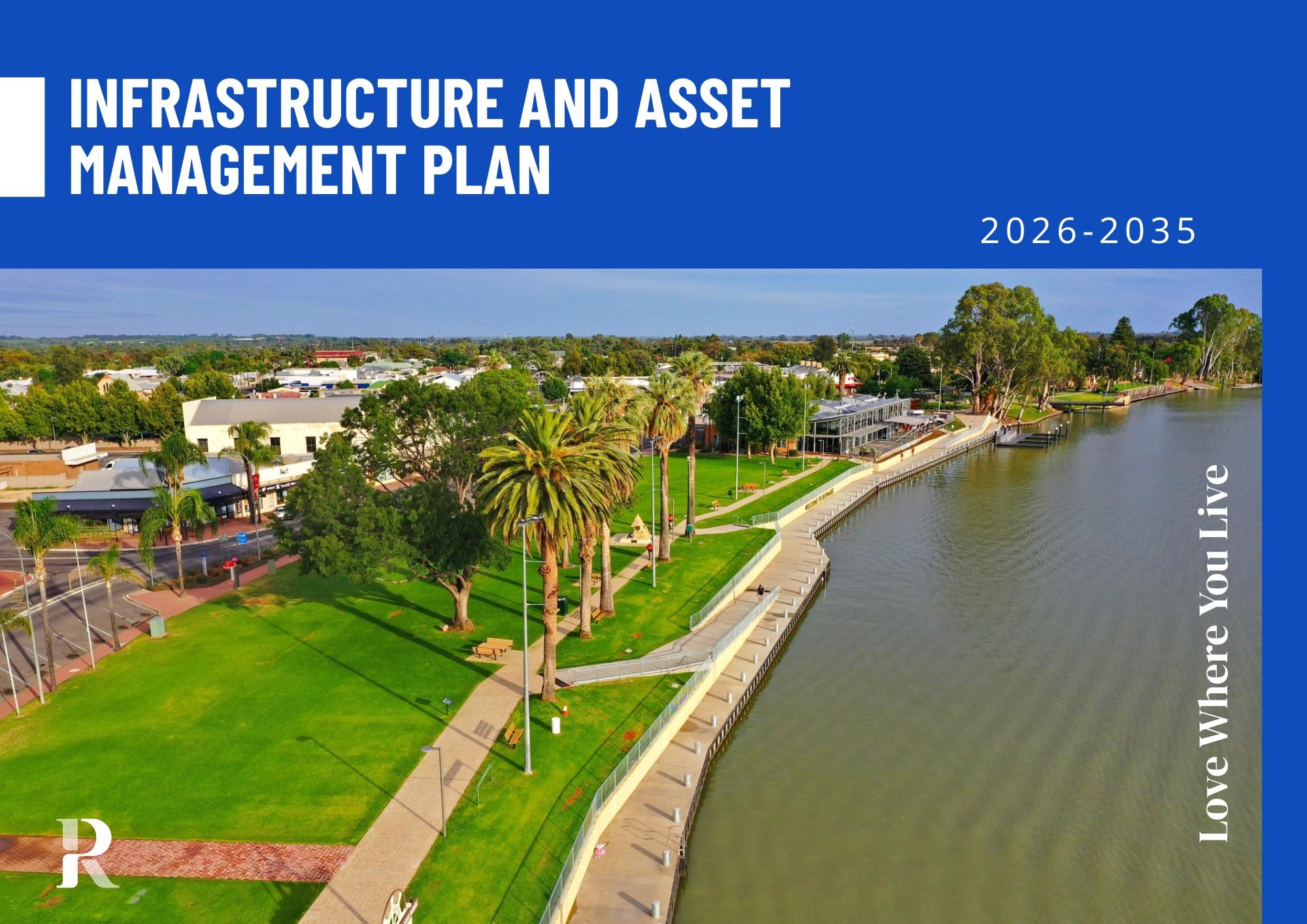

DRAFT
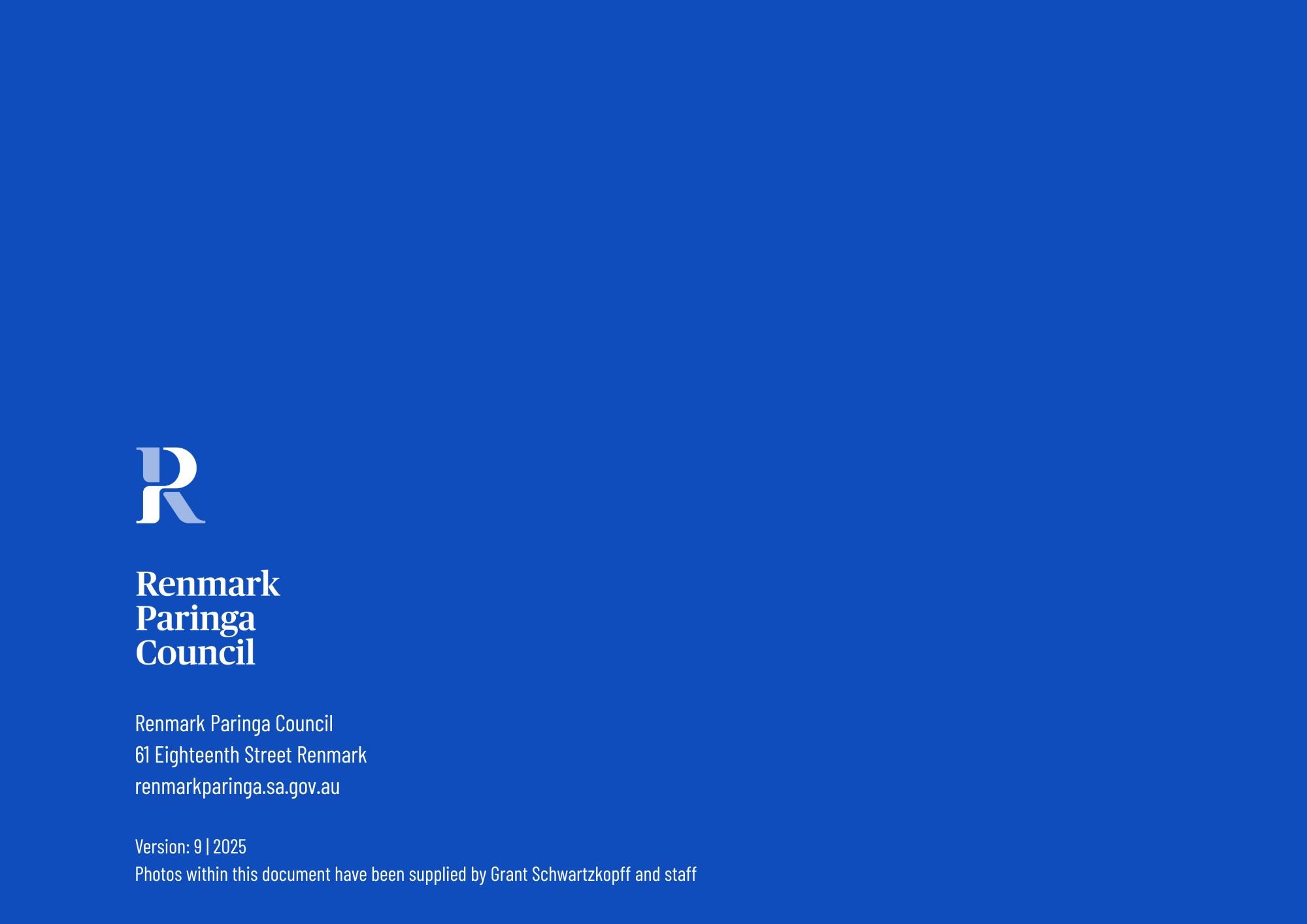
DRAFT
INTRODUCTION
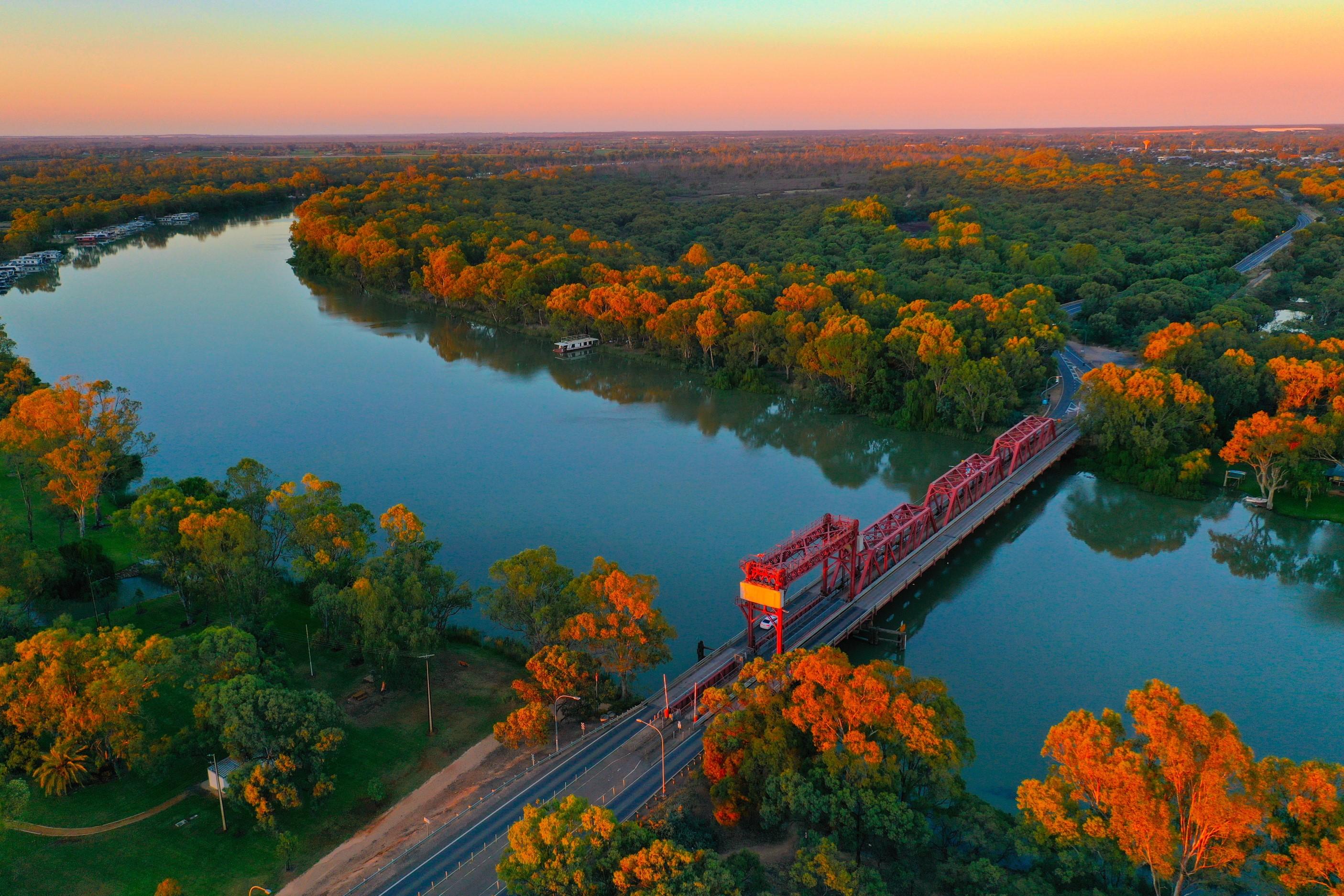
Renmark Paringa Council covers an area of approximately 407 square kilometres and is home to approximately 10,000 residents. Our major settlements include Renmark, Paringa and Lyrup which are rich with agriculture and tourism opportunities.
The purpose of this Infrastructure and Asset Management Plan (IAMP) is to demonstrate our responsible management of assets, our compliance with regulatory requirements and to identify the funding required to provide the requisite levels of service to maintain, operate, renew and improve our assets and infrastructure.
Our goal in managing infrastructure assets is to meet our required levels of service in the most cost effective and efficient manner for present and future users. The key elements of infrastructure asset management are:
Incorporating a life cycle approach,
Developing cost-effective management strategies for the long term and taking into account community benefit,
Providing levels of service and monitoring performance,
Understanding and meeting the demands of growth through demand management and infrastructure investment,
Managing risks associated with asset failures,
Sustainable use of physical resources, and
Continuous improvement in asset management practices.
One of our greatest challenges is maintaining our large asset base and prioritising our capital works programs. To achieve this we will be focusing on improving our understanding of the condition and utilisation of our assets to ensure we make better and more informed decisions for their management.
In order to continue to manage our organisation in a responsible, sustainable and progressive manner we are aiming to develop more robust systems and processes around our asset management to ensure we continue to improve the way we manage, renew and upgrade our assets and infrastructure while maintaining our strong financial position.
We are also cognisant of the emerging challenge of climate change and how this will influence the way we manage our infrastructure. We aim to address these challenges in a proactive manner on behalf of our community.
This revision of the Infrastructure and Asset Management Plan has included greater provisions for renewing our assets throughout the 10 years of this plan whilst we continue to gain further data on the condition of our assets across all classes.
Community Plan
Where are we going? What do we want to achieve?
STRATEGIC FRAMEWORK
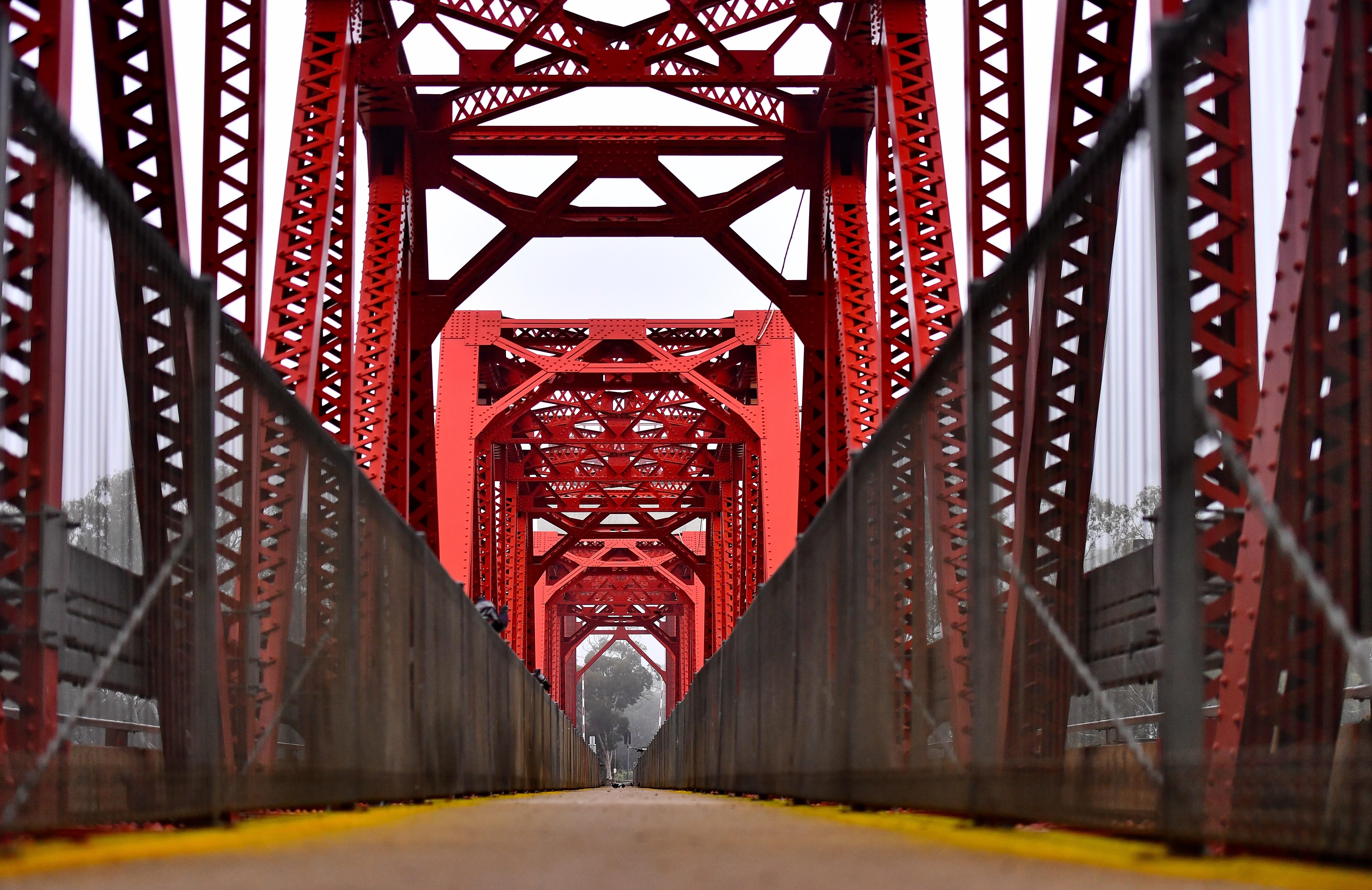
The adjacent diagram demonstrates how our strategic framework fits together and the key documents that establish this framework.
Infrastructure and Asset
Management Plan
Long Term
Financial Plan
Other Strategic Plans
Annual Business Plan and Budget
What are the activities and outcomes to be achieved this year? How will we allocate resources?
Annual Report
What outcomes did we achieve this year?
This IAMP forms part of our suite of strategic plans as required by Section 122 of the Local Government Act 1999. Section 122 also requires us to have a Community Plan and a Long Term Financial Plan. Our Community Plan identifies our vision and strategic outcomes.
The following goals and strategies contained within our Community Plan influence the structure and direction of the IAMP.
LIVEABLE
A safe and welcoming place to live a healthy and active lifestyle.
PROSPEROUS
A place that attracts, retains and supports talented people, underpinned by diverse regional industry, tourism and access to housing.
ENVIRONMENT
A place that is resilient to the effects of extreme weather, protects its river, is green and limits its impact on the natural environment.
LEADERSHIP
A Council that is a trusted partner that delivers what it promises in an efficient and effective way.
During the annual review of this asset management plan, each of the documents within the framework are
STRATEGIC ALIGNMENT
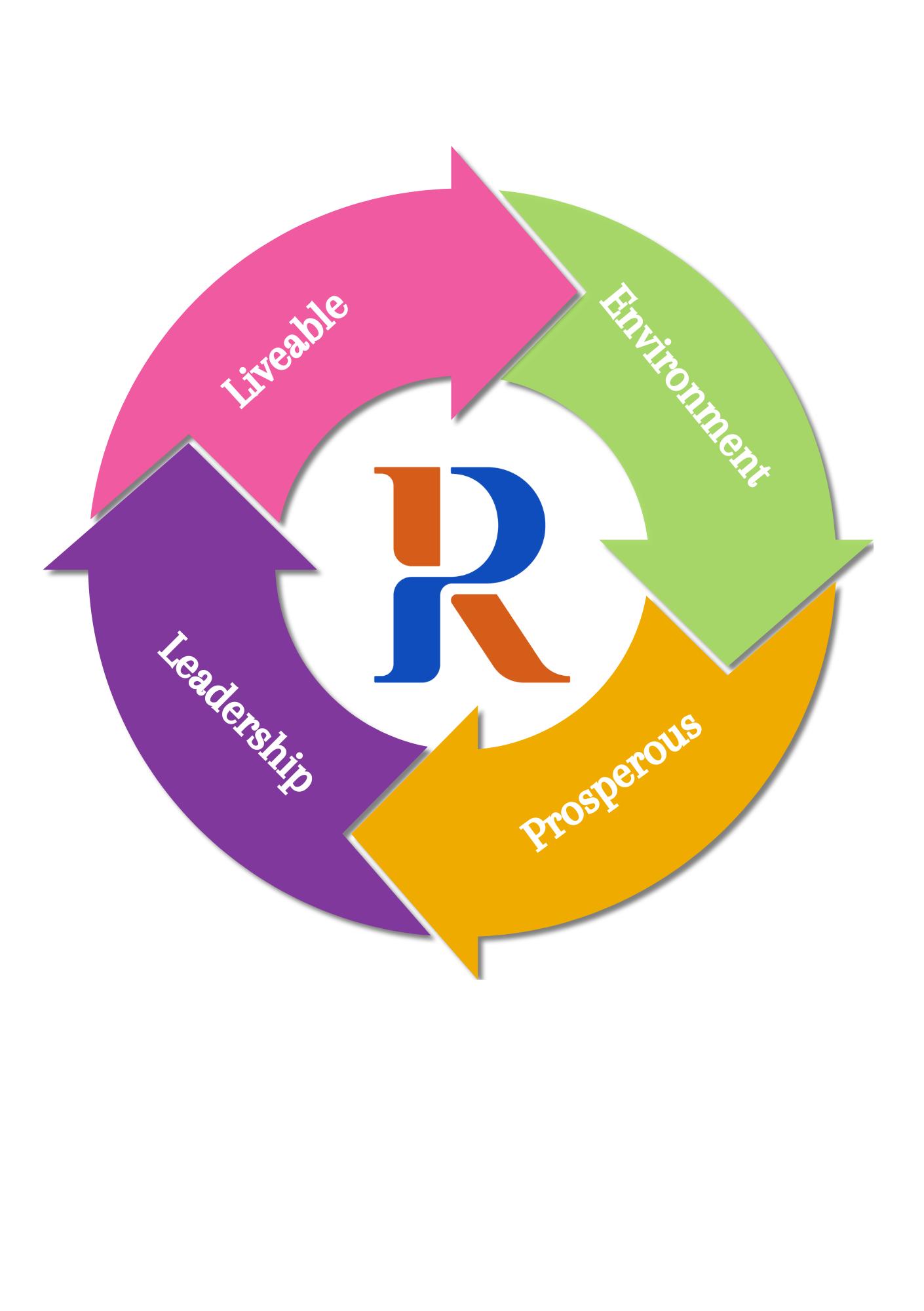
DRAFT
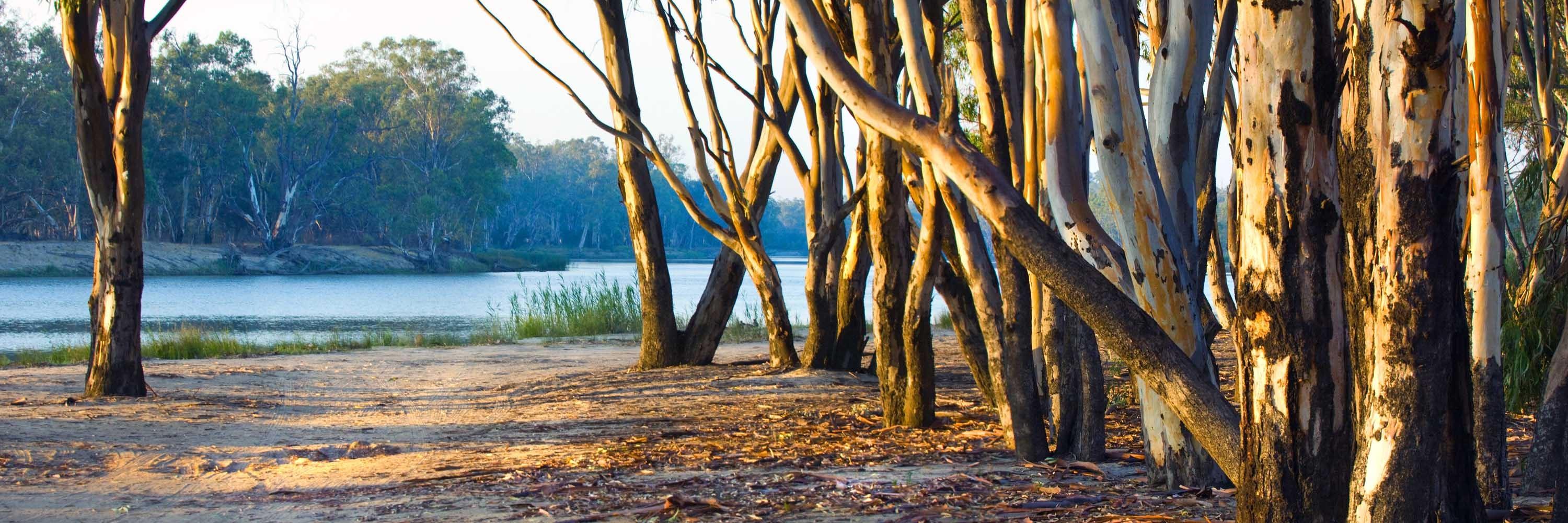
SUSTAINABILITY
Sustainability is defined as the capacity of something to be maintained at a certain rate or level. There are many elements to consider when assessing sustainability however for the purpose of this plan we have grouped the elements under financial, environmental and social sustainability.
FINANCIAL SUSTAINABILITY
Is the plan affordable?
As demonstrated by the chart adjacent, the majority of forecast expenditure over the life of the plan is on the continued maintenance, operation and renewal of the Infrastructure and Asset network. As the IAMP directly links to our Long Term Financial Plan the continued provision of services, at least to the current standards, is financially sustainable. This will need to be closely monitored to ensure it remains affordable.
Our primary focus during the life of this plan is on the maintenance and renewal of current assets rather than the creation of new assets, however should any funding opportunities become available these will be considered in line with the priorities outlined in this plan. This is supported within Council’s Community Plan with the Asset Management Focus Area: E1.
This IAMP will be reviewed on an annual basis as part of the Annual Business Planning process to ensure that any unforeseen circumstances can be assessed and appropriately responded to and that the proposed schedule and timing of works is suitable.
DRAFT
SOCIAL AND SERVICE SUSTAINABILITY

Do the assets and services meet the community s needs and can they continue to meet those needs into the future?
We surveyed our community in 2023 and the results were very encouraging and reflects that we are generally meeting the expectations of our community. The survey indicated providing and maintaining recreation options are important to nearly all respondents, with ‘Providing and maintaining sporting facilities, parks, gardens, playgrounds, reserves, and swimming pools’ as the most important Council service (96%)
As indicated by the results of the Community Survey, the current assets and services broadly meet the community s needs at this time and this plan seeks to maintain our current service levels.
SERVICE LEVELS
Through our asset management journey, we intend to develop customer and technical service levels for each asset class. These will outline the expectations that our customers have and align to our affordability to provide those assets.
These service levels will integrate into our capital works planning and proactive maintenance management.
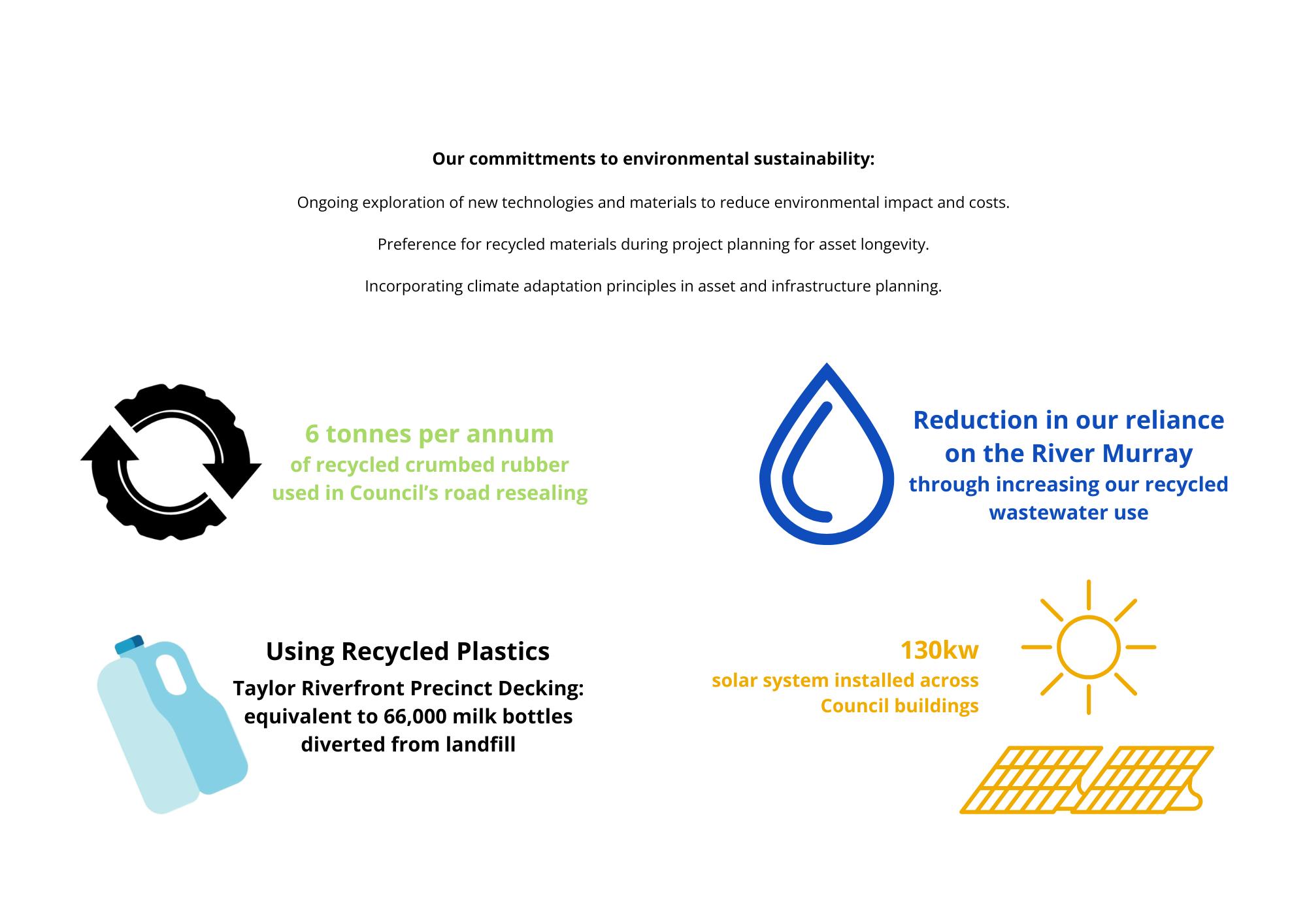
DRAFT
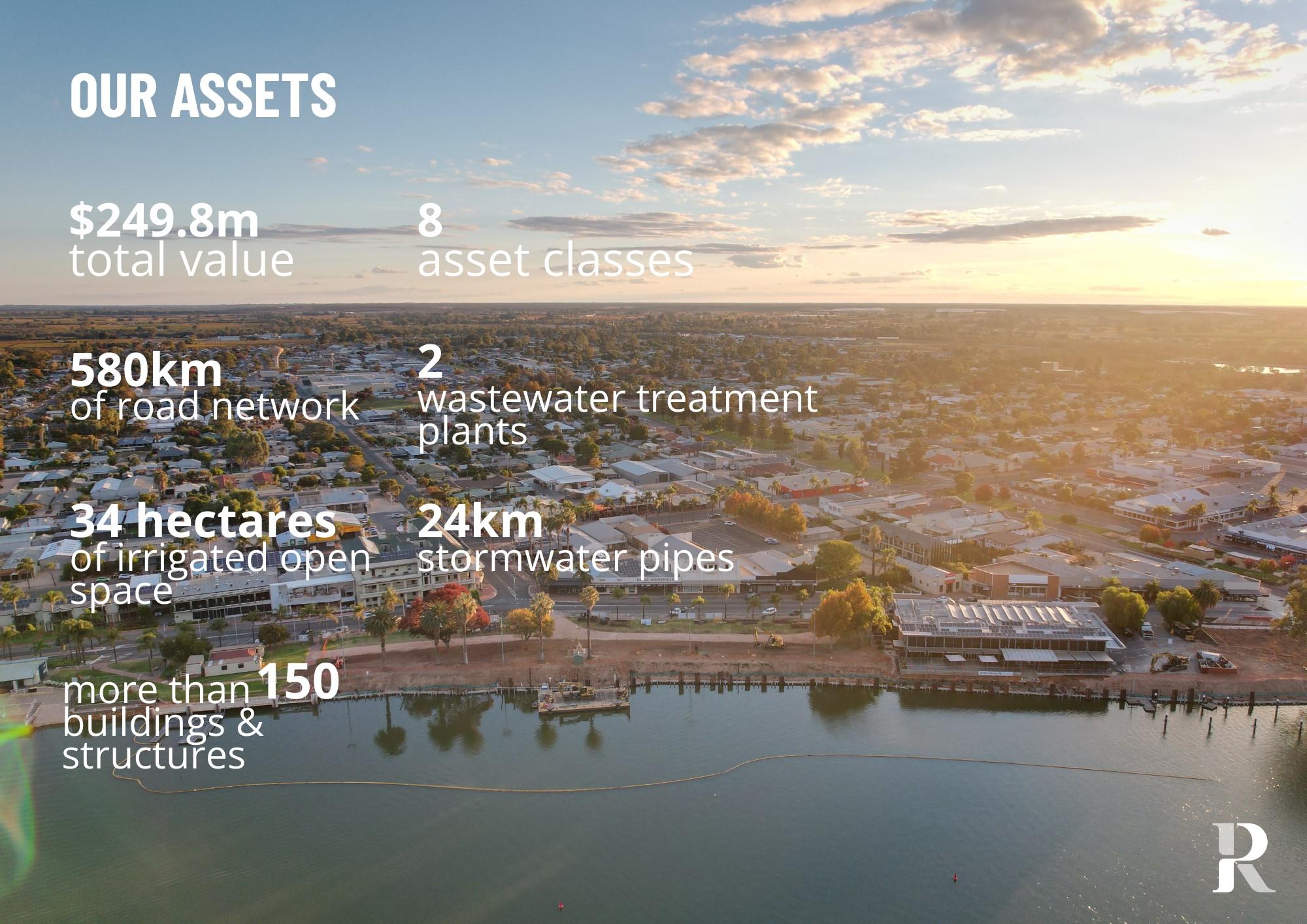
DRAFT
ASSET MANAGEMENT
Our journey to implement asset management processes and plans commenced in 2008 with the collection of condition data on our road and transport network as well as the creation of a road register. At this time we commenced our successful partnership with Tonkin who have assisted us with our asset management practices ever since. The majority of our asset data is contained in Conquest, a software program that Tonkin manages on our behalf. In 2010 our Community Wastewater Management System (CWMS) register and Stormwater register of assets were set up in Conquest. This has continued into other asset classes with the addition of Transport., Irrigation. The Buildings and Structures portfolio is currently transitioning across and will be merged into Conquest in 2025/26.
CONDITION ASSESSMENTS
Over the last decade we have undertaken 3 condition audits of our transport assets and have revalued these assets on 5 occasions. Our CWMS and stormwater assets have been revalued on 2 occasions in this period. Most recently, we have conducted condition assessments on our CWMS, Stormwater and Irrigation asset classes. This has impacted the value of these portfolios and in turn the depreciation amounts.
In 2022 we completed a condition audit of our CWMS Assets, this has provided us valuable data for programming maintenance and renewal works into the future. The Stormwater Network has been identified for the next full condition assessment commencing in 2023 and will be undertaken over multiple years in conjunction with the updating of our Stormwater Management Plan.
As the CWMS, Irrigation and Stormwater Networks have extensive underground assets with long useful lives, the cycle for completing full condition assessments are reflective of this. We have implemented proactive maintenance management to inspect above ground assets to monitor the condition of these.
ASSET MANAGEMENT AND COSTS
The table below outlines the future program for condition assessments of our asset portfolio:
DRAFT
REVALUATIONS
Desktop revaluations for accounting purposes are conducted annually in alignment with Council’s Asset and Accounting Recognition Policy.
It should also be noted that Plant and Machinery and Furniture and Fittings classes are valued at cost and do not require assessments.
ASSUMPTIONS WITHIN THIS PLAN
Appendix 3 outlines the capital programs over the life of this plan by asset class, of which an 2.5% indexation has been applied to address inflation. The operating and maintenance costs are represented in Appendix 4.
We receive Roads to Recovery Program from the Australian Federal Government. The current program spans from 2024-2029. The years beyond this program life have assumed the year 5 allocation of the current program.
In 2020, we completed a condition audit of Council’s category 1 and 2 buildings assets. This information is now used to inform planning asset maintenance and renewal.
Following the advice received from ESCOSA, we have incorporated provisions in the outer years of the plan to account for asset renewals that are not yet quantified. This has been implemented to align to Council's asset renewal ratio.
OUR PORTFOLIO
ASSET COSTS
The estimated expenditure to provide the services covered by this IAMP over the next 10 years is $124,557,029 which equates to an average of $12,455,702 per year. This includes operations, maintenance, renewal and upgrading of existing assets as well as the creation of new assets as identified.
During the life of this plan, the estimated capital renewal expenditure is $57,832,127 which equates to on average $5,783,213 per annum. We have prioritised renewing our existing assets over building new, to support the approach of providing high quality infrastructure to our community.
We will continue to investigate and secure external funding opportunities for capital new and upgrade projects which if successful may alter the priorities of this plan.
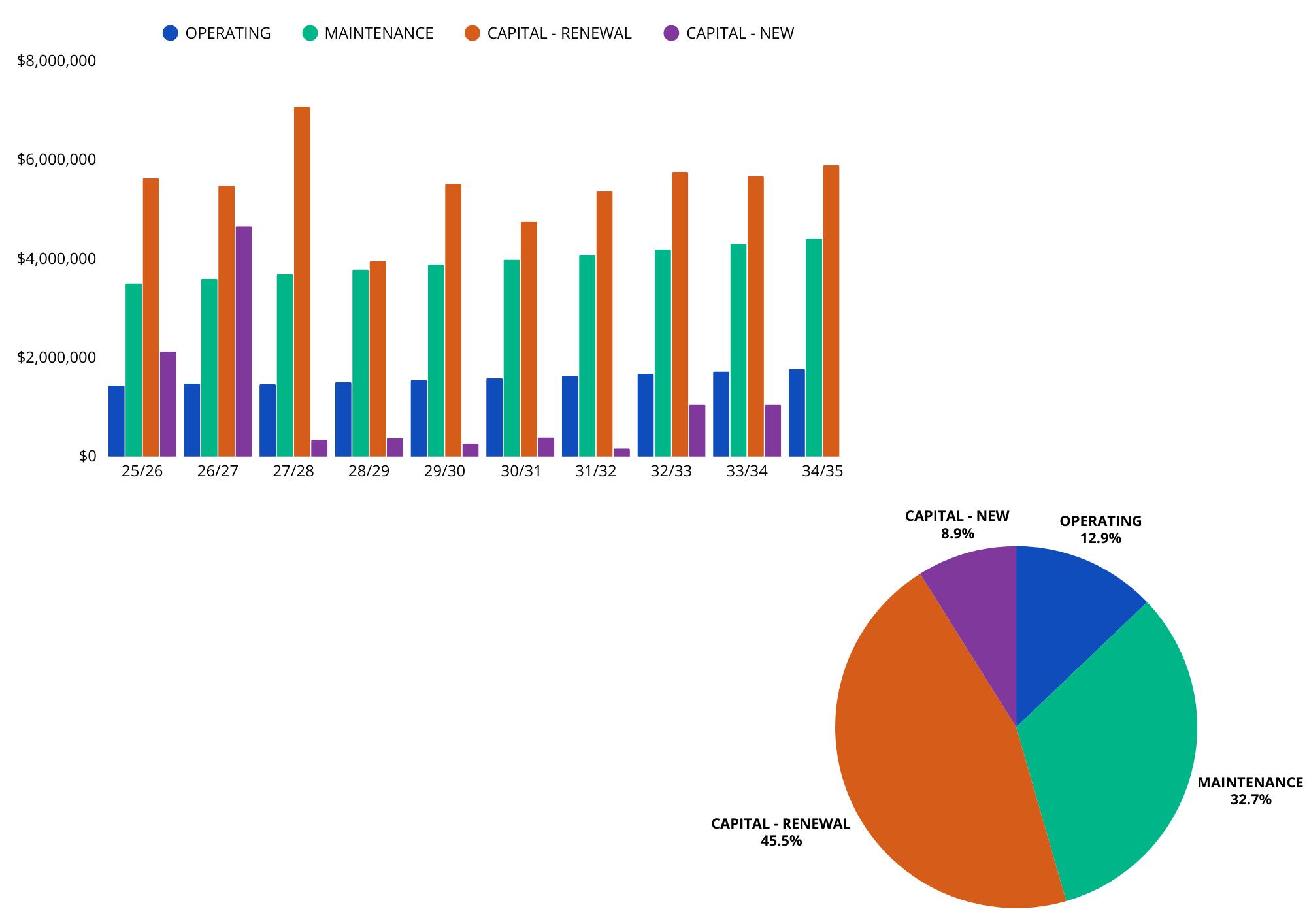
$124.5m estimated expenditure over the next 10 years
$69.3m of Capital Renewal and New / Upgrade Expenditure over the next 10 years

FUTURE PRIORITIES, CHALLENGES AND OPPORTUNITIES
The overarching theme of our priorities, opportunities and challenges focus on us increasing our asset management maturity. Many of the priorities listed below are captured in our Strategic Asset Management Review and are reported on via the asset management improvement plan. This improvement plan is tabled quarterly at the Asset Committee. A high level of this improvement plan and associated priorities are listed below:
PRIORITY: FINANCIAL SUSTAINABILITY
We are trying to reduce the average capital expenditure from current levels to ensure financial sustainability. The previous 5 years have delivered several major new projects, in this iteration of the plan, we have optimised the capital expenditure focussing on renewal to ensure long term financial sustainability. This has included incorporating provisions for asset renewals in the outer years of the plan, where there is not any identified asset renewal projects based on condition data.
Complete Asset Registers and On-going Consolidation of the Asset System
In addition, we have identified the need to undertake a thorough audit of our building assets to assist with identifying any required maintenance, capital renewal as well as opportunities for consolidation of these assets. Furthermore, the asset categories of Public Domain Infrastructure Furniture and Fittings require audits to determine on-going maintenance and capital renewal expenditure.
The more we can improve our data and information on each asset category the more informed our decision making processes will be.
Improve the IAMP
As new data becomes available we will progressively update this IAMP and ensure it is consistent with our Long Term Financial Management Plans and budgeting. We are working towards this document progressing towards a Strategic Asset Management Plan supported by individual asset management plans for each asset class. The framework of these documents will align with the model documents published by Institute of Public Works Engineering Australasia and supported by the Local Government Association of SA.
DRAFT
PRIORITY: ASSET MANAGEMENT ROLES AND RESPONSIBILITIES
We have made progress with the allocation of additional human resources dedicated to the role of asset management. This role will further grow and progress our dedication to good practice asset management and include ongoing training and development in this field.
Development of Proactive Maintenance Management
We aim to explore defect logging and developing workflows to approve, action and close out works in a proactive manner using mobile technology and integrating with Conquest. A trial of this technology for footpath maintenance was continued in 2024/25 and will incorporate other asset classes in the coming year.
GIS Review
Geographic Information Systems (GIS) play an intrinsic role in asset management and as such we will aim to review current extracts in our mapping within Exponare (a software program) to ensure they are current and up to date. We will undertake a needs analysis across the organisation and develop a plan to improve our GIS data and systems across Council.
PRIORITY: FLOOD RESILIENCE
Our experience during the 2022 River Murray Flood has demonstrated that Council’s infrastructure and assets need to have a higher level of flood resiliency. This was evident within the stormwater network in particular and future stormwater improvements will have consideration to flood resilience and overall betterment of our assets.
The Stormwater Management Plan currently under review will reflect our learnings from this event and identify improvements to our network to prepare for future flooding events.
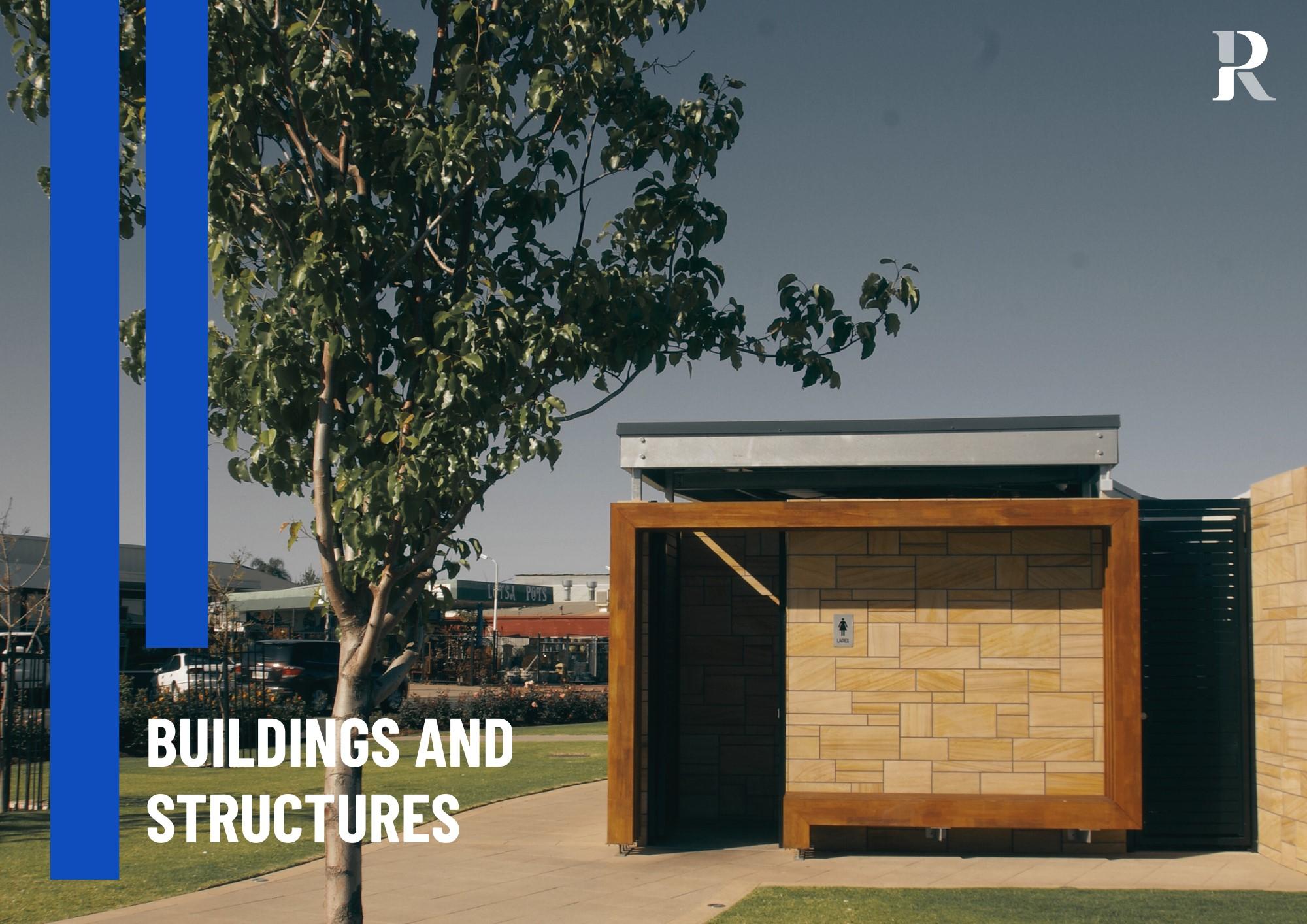
DRAFT
BUILDINGS AND STRUCTURES
Council provides over 150 buildings and structures, which deliver core services such as Council administration, library services, sport and recreation, culture and the arts, children's services, visitor information, aged and disability services and public amenities. Past investment by the community and the significance of this asset class means it is important that this infrastructure meets a level of service acceptable to the community now and into the foreseeable future.
WHAT DOES IT COST?
There are two key indicators of cost to provide Community Buildings. The life cycle cost being the average cost over the life of the asset and the total maintenance and capital renewal expenditure required to deliver existing service levels over the next 10 years as detailed in Council’s Long Term Financial Plan.
The average life cycle cost (made up of maintenance and depreciation) of Renmark Paringa Council’s existing Building portfolio is estimated at $1,705,616 per annum.
Council’s average planned life cycle expenditure (made up of maintenance and planned capital renewal) over the next 10 years is $1,622,195. These two figures provide an initial indicator of lifecycle sustainability, which for this asset class is 95%.
The total forecast expenditure required to provide this portfolio over the next 10 years is estimated at $19,853,334 (this incorporates maintenance, operating, capital - renewal and capital - new). This is an average of $1,985,333 per annum.
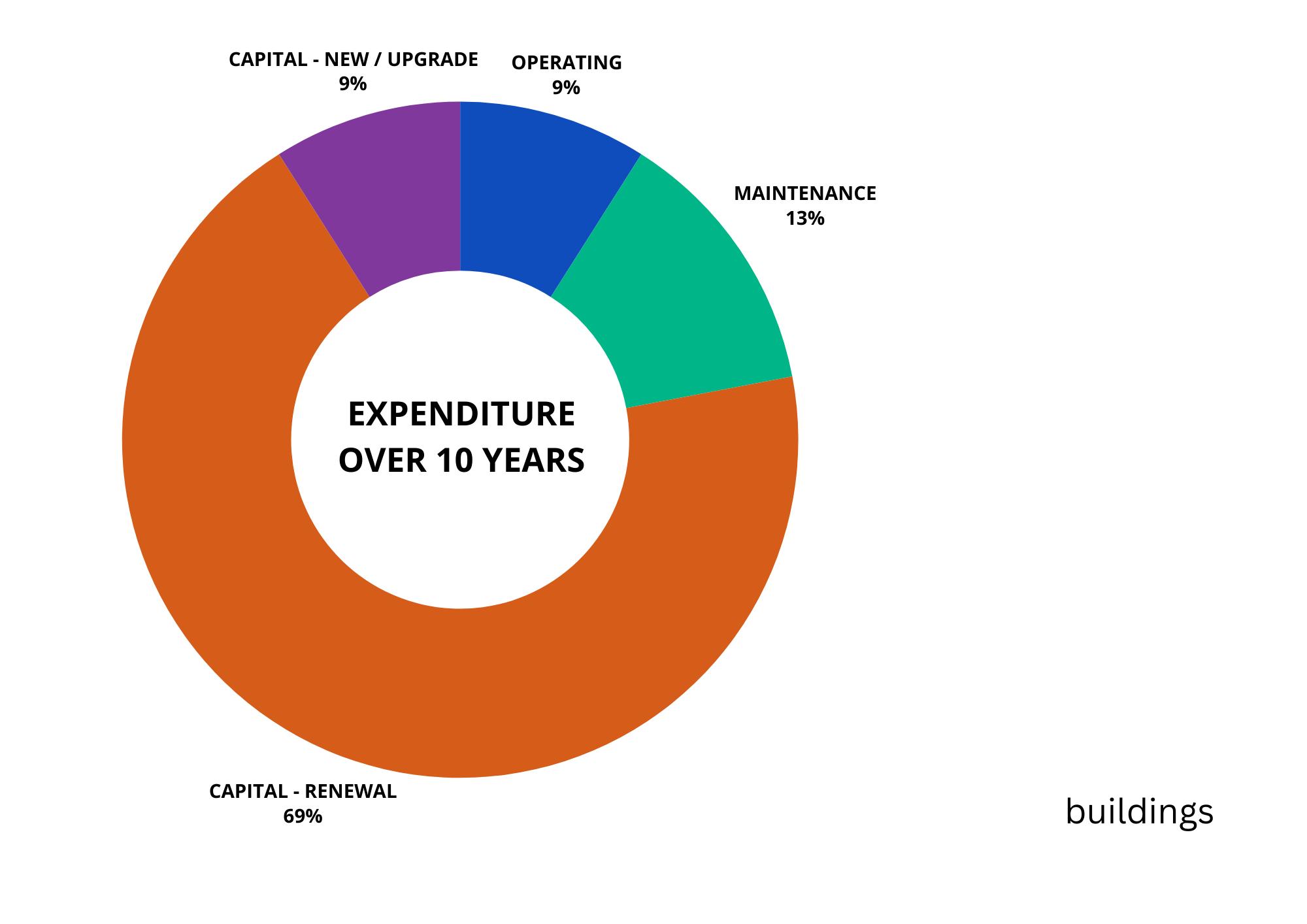
$44.67m
Operating
Operating includes costs associated with operating the building asset. This can vary for each asset but includes costs such as electricity, telephone, water and security monitoring. The current forecast Operating expenditure over the next 10 years is $1,791,383
Maintenance
Maintenance includes costs associated with maintaining the building asset. This can vary for each asset but includes costs such as cleaning, maintenance to painted services, septic tank pumping, fire equipment inspections (all provided by contractors), minor services and repairs (air conditioning, electrical, automatic doors, etc). This can also include internal costs (staff and plant) to maintain the land and buildings (outdoor staff doing minor repairs and landscaping). The current forecast Maintenance expenditure over the next 10 years is $2,706,081.
Capital - Renewal
Capital - Renewal is capital costs associated with renewing or replacing current assets and infrastructure (restoring to original service level). The current forecast CapitalRenewal expenditure over the next 10 years is $13.513,871
Capital - New
Capital - New is capital costs associated with upgrading or creating new assets and infrastructure (above original service level). The current forecast Capital - New expenditure over the next 10 years is $1,840,000.
FUTURE PRIORITIES, CHALLENGES AND OPPORTUNITIES
The previous building assets condition assessment has informed future capital programs and maintenance expenditure detailed within this IAMP. This condition assessment has highlighted the requirement for ongoing inspections and programming maintenance of our building assets. This has been demonstrated through various buildings in our portfolio that are requiring significant renewal works and should have overall consideration to our long term intentions for these assets.
DRAFT
This asset class is scheduled for a condition assessment in 2025-26 which will inform the future years of forecasted capital investment.
OUR STANDARDS
Quality and Function
Our intent is to deliver building assets that are suitably fit for purpose and maintained and repaired as appropriate while meeting regulation and standard requirements. Issues found or reported that are outside normal maintenance and/or servicing will be assessed and appropriate remedial action taken. It is noted that some buildings are leased by external parties and certain obligations rest with the lessee.
Safety
Safety is paramount and appropriate signage and equipment will be provided as needed to ensure public safety. Due to the large number of buildings and structures, the public plays an important role in the reporting of any safety issues and defects. Periodic inspections of buildings takes place with regard to fire safety, asbestos and WHS. Any reported safety issue, defect or hazardous materials will be assessed as a matter of priority and appropriate remedial action taken.
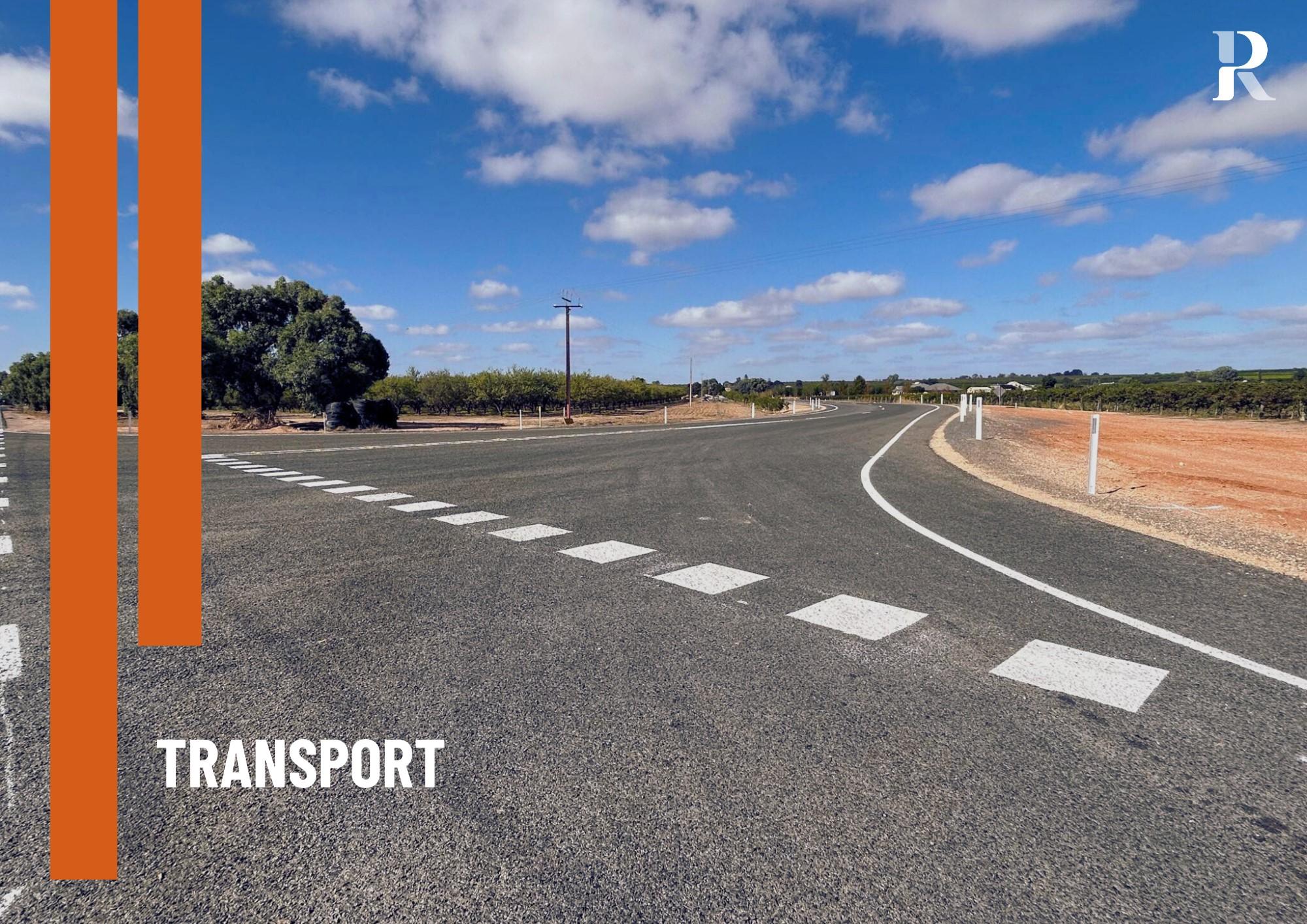
DRAFT
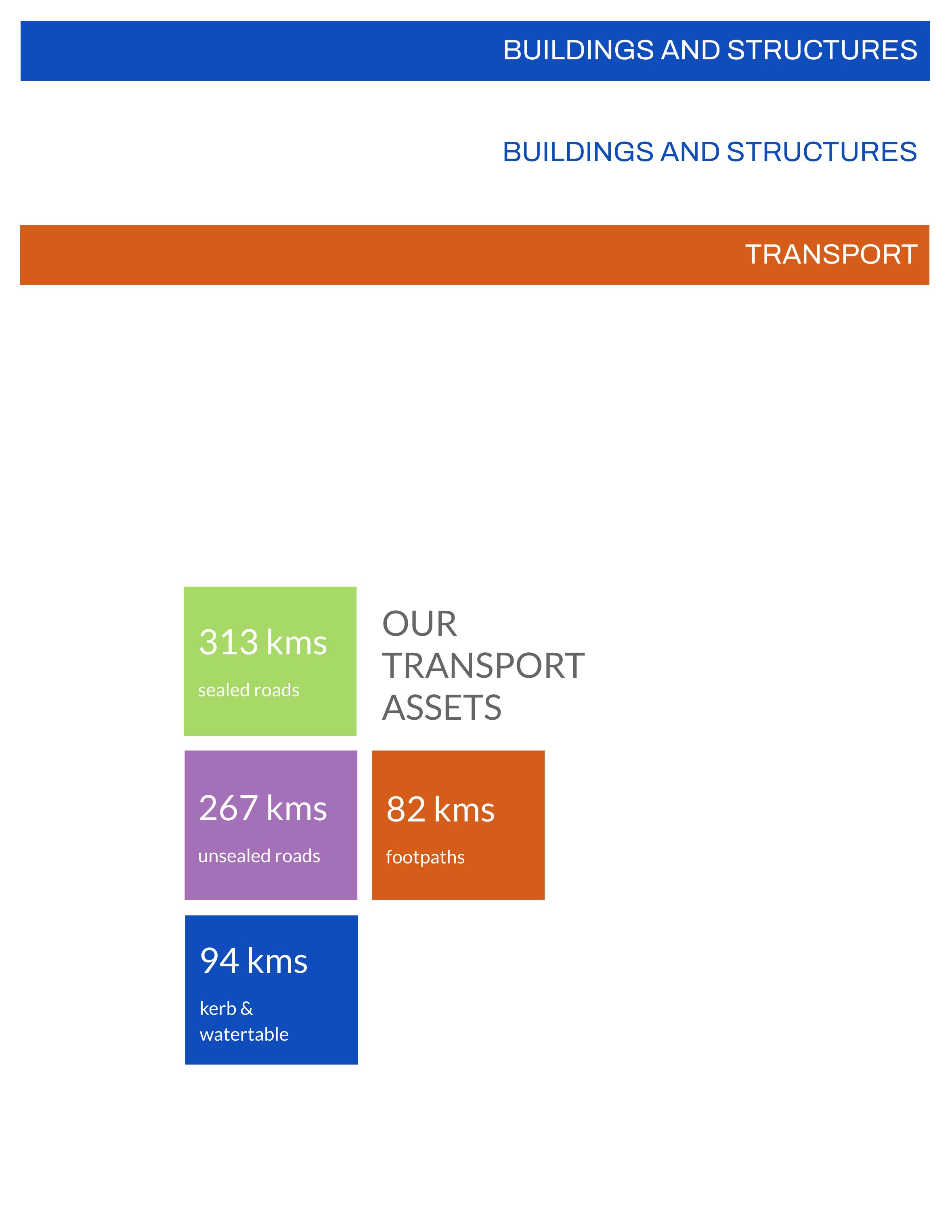
Our transport assets and infrastructure make up over 45% of our entire assets therefore our management of them is critical to our ongoing sustainability.
DRAFT
There are two key indicators of cost to provide the Transport Network. The life cycle cost being the average cost over the life of the asset and the total maintenance and capital renewal expenditure required to deliver existing service levels over the next 10 years as detailed in Council’s Long Term Financial Plan.
The average life cycle cost (made up of maintenance and depreciation) to provide the Transport Network is estimated at $4,594,153 per annum. Our average planned life cycle expenditure (made up of maintenance and renewal) over the 10 years is $3,411,807. These two figures provide an initial indicator of lifecycle sustainability, which for this asset class is 74%.
The total forecast expenditure required to provide the Transport Network service in the next 10 years is estimated at $40,578,138 (this incorporates maintenance, operating, capital - renewal and capital - new / upgrade). This is an average of $4,057,814 per annum.
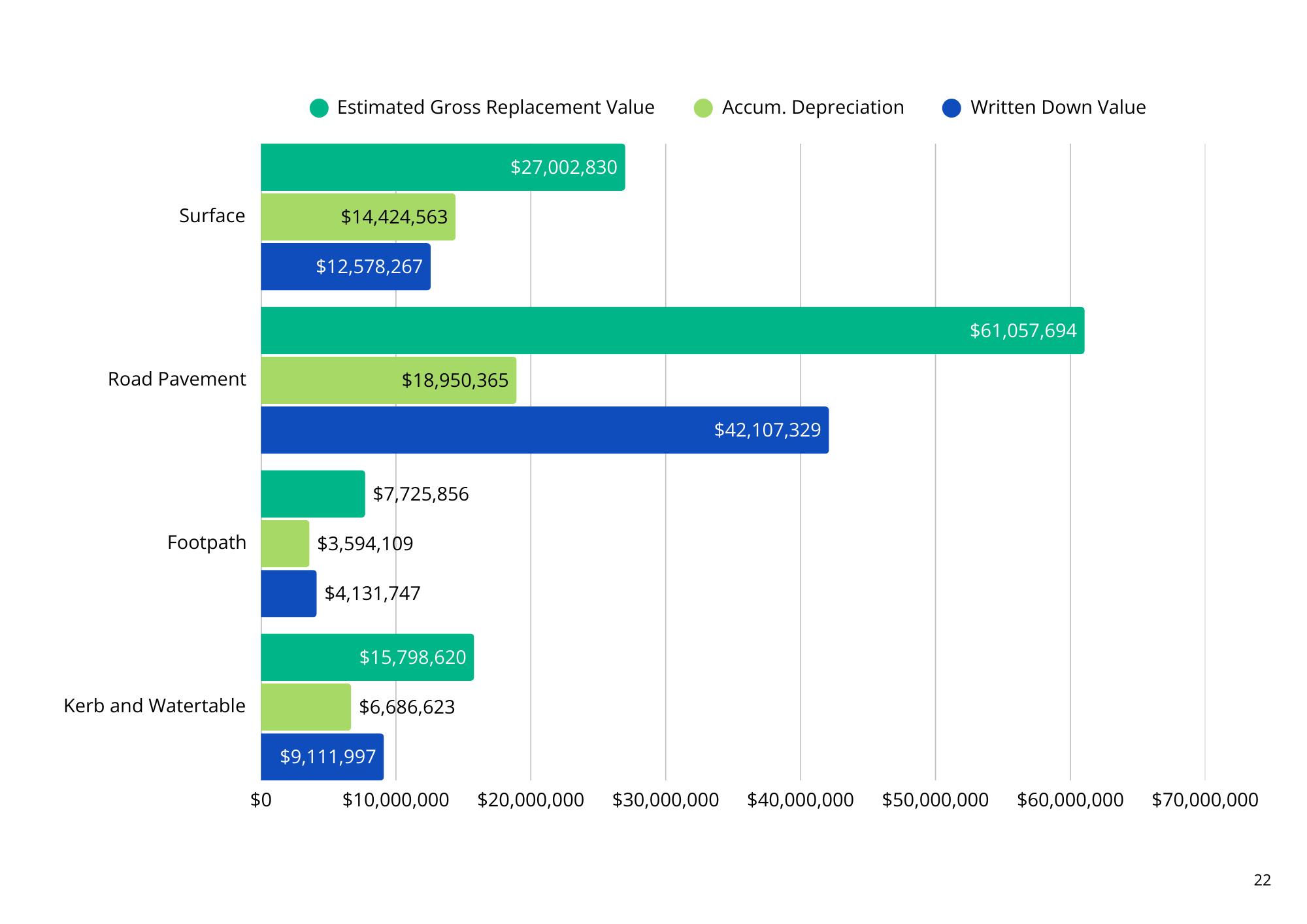
FORECAST EXPENDITURE
Operating
Operating forecast expenditure includes costs associated with hosting the Asset Management System (Conquest) that Council uses to manage the road network and the costs associated with updating the data within this system (undertaken in collaboration with Tonkin Consulting). The current forecast Operating expenditure over the next 10 years is $1,392,505
Maintenance
Maintenance includes costs associated with staff and machinery to repair general wear and tear of both the sealed and unsealed road network such as shoulder grading, patrol grading, repairing pot holes, replacement of signs, traffic management and road shape correction. The current forecast maintenance expenditure over the next 10 years is $16,026,959
Capital - Renewal
Capital - Renewal is capital costs associated with renewing or replacing current assets and infrastructure (restoring to original service level). Council has a 3 year road resealing agreement which was negotiated in conjunction with the District Council of Loxton Waikerie and Berri Barmera Council as part of the G3 Alliance. The current forecast Capital - Renewal expenditure over the next 10 years is $18,091,110
Capital - New / Upgrade
Capital - New / Upgrade is capital costs associated with upgrading or creating new assets and infrastructure (above original service level). The current forecast Capital - New expenditure over the next 10 years is $5,067,563
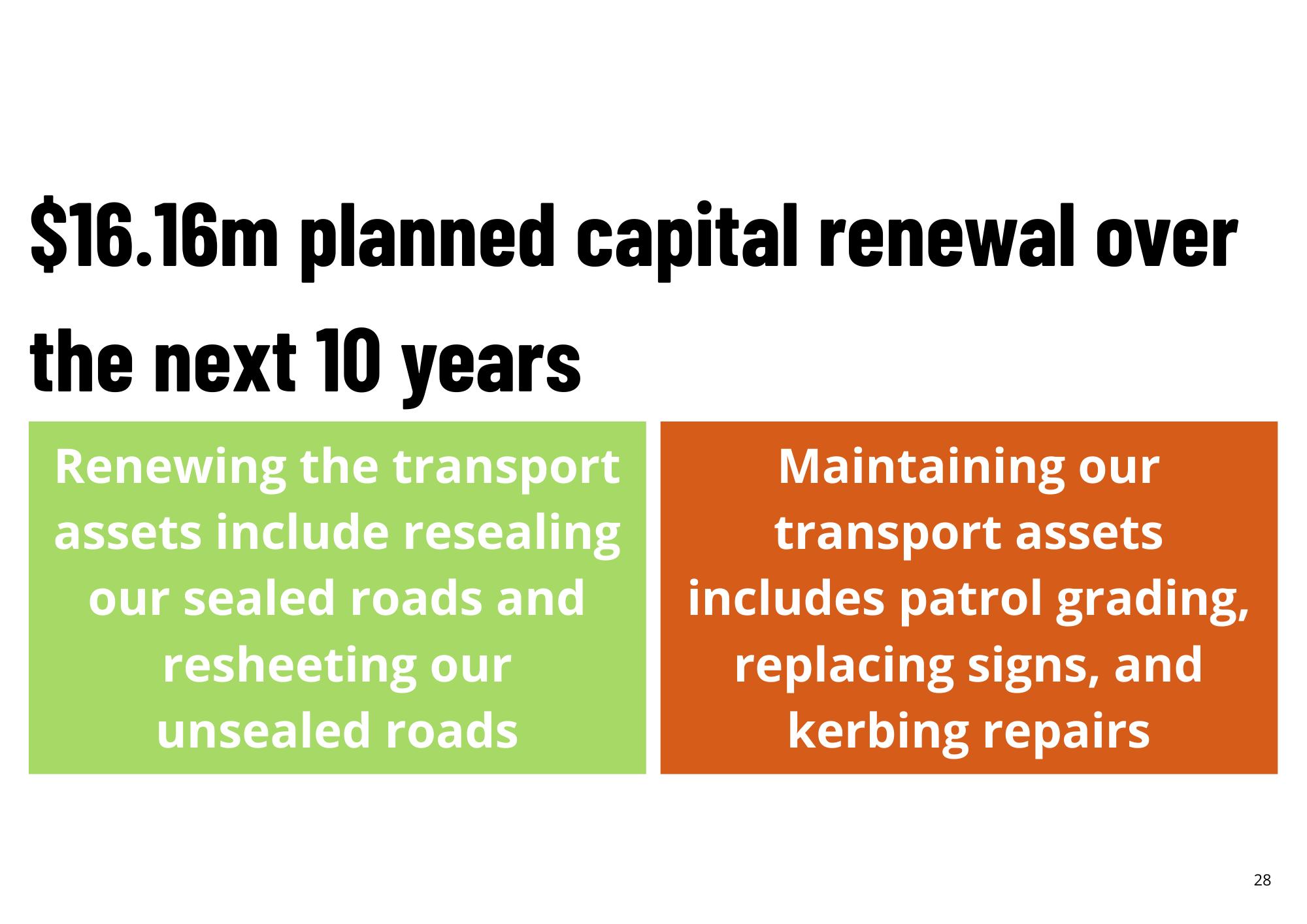
$18.09m
Capital renewal expenditure forecasted over the next 10 years
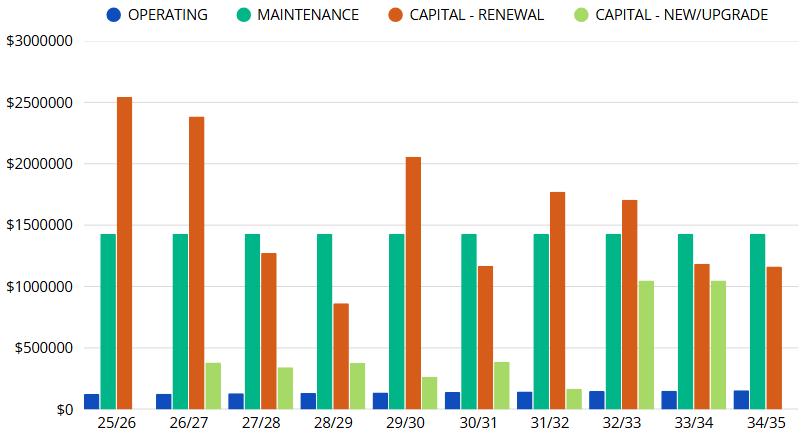
EXPENDITURE BY TYPE OVER THE 10 YEARS
FUTURE PRIORITIES, CHALLENGES AND OPPORTUNITIES
Roads
We are committed to resealing our sealed road network within the useful life of the asset to ensure the maximum life for road pavements is achieved. We have made considerable investment in our resealing program and this has ensured this asset will continue to be kept at an appropriate standard.
The most recent condition assessment has highlighted roads which are requiring a greater level of intervention and are needing pavement repairs. We have commenced addressing these interventions in the early years of the capital programs.
We will continue to review and assess our road network to identify any future opportunities to utilise Special Local Roads Program funding to upgrade our road network.
A major project that we have identified is the upgrade of intersections of some of our General Mass Limits (GML) and Commodity routes that have been assessed as high risk for B-Double vehicle movement. We are have developed concept plans for these intersections which were half funded through the Murraylands Riverland Local Government Association (MRLGA). The upgrade and construction of the intersections has been included in our future capital programs. The aim of this project is to support our local industries and ensure safe heavy vehicle access to our road network. Due to the cost of these upgrades, these have been scheduled in the later years of this document.
Footpaths
We have undertaken a defect and condition audit of our footpaths in 2020/21, which will assist us to determine appropriate levels of expenditure on maintenance and any future capital works that are required. In the evolution of reviewing this data and understanding our network, we have implemented proactive maintenance management to assist our operations team to respond to footpath repairs in a effective and efficient manner.
Kerb and Watertable
In 2017, staff undertook an audit to identify streets within Renmark, Paringa and Lyrup which did not have kerb and watertable. This audit endorsed by Council, included the prioritisation of the streets to be completed. The outcomes of this audit has been scheduled within future capital programs and works has been prepared with consideration given to combine areas together or based on priority. As this is an increased service level that what is currently provided, these are commencing from 2026/27.
Flood Resilient Transport Assets
DRAFT
Our community was one of the many impacted by the 2022 River Murray Flood. This natural disaster impacted approximately 23 kilometres of Council’s road network and significantly damaged the Twentyfirst Street Bridge. Subsequently, independent advice identified this bridge was no longer safe for public access and should be reviewed for replacement. This major project was successfully delivered during 2024/25 and was opened to the public in May 2025.
OUR STANDARDS
Quality and Function
Transport assets will be maintained in a suitably usable condition. Issues found or reported that are outside normal maintenance and/or servicing will be assessed and appropriate remedial action taken. Our intent is that an appropriate Transport Network is maintained across our district in partnership with both State and Federal Government to provide a network that services both the present and future needs of the community.
Safety
Transport asset attributes will be maintained at an appropriately safe level and signage and equipment will be provided as needed to ensure public safety. We inspect all transport assets regularly and any reported issues will be assessed as a matter of priority and remedial action taken.
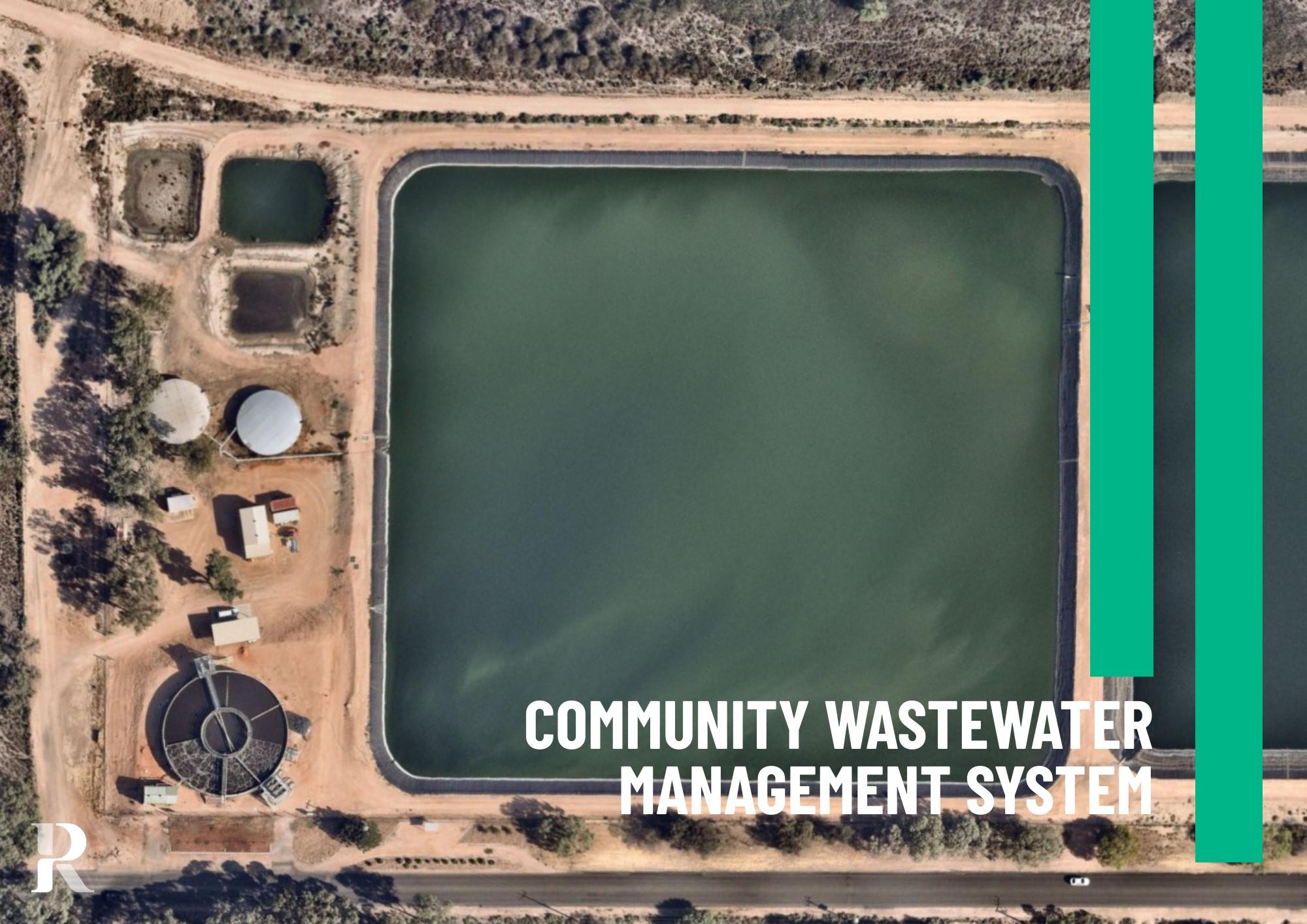
DRAFT
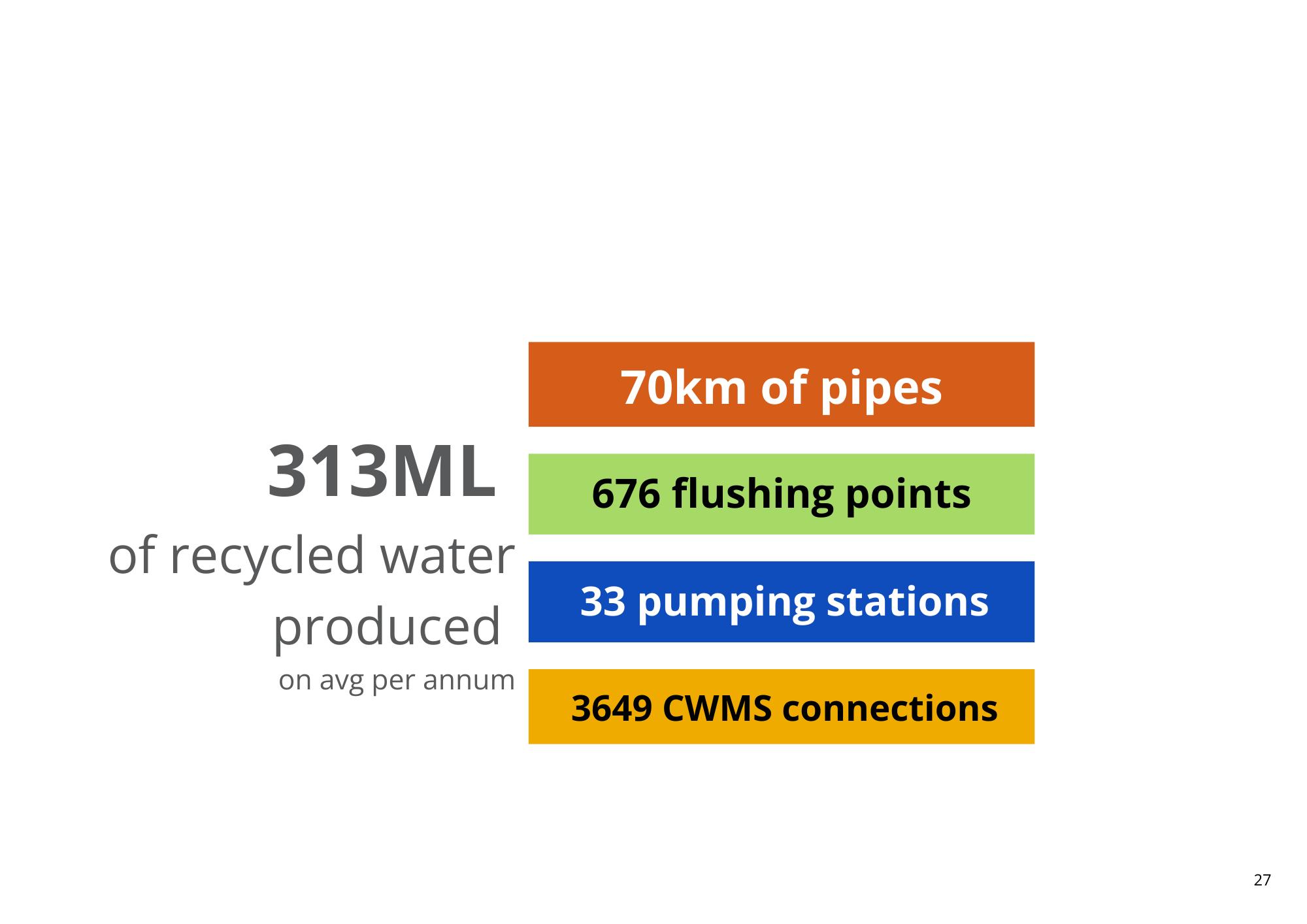
COMMUNITY WASTEWATER MANAGEMENT SYSTEM
We are responsible for maintaining a network of Community Wastewater Management Systems (CWMS) assets within the townships of Renmark and Paringa as well as the Calperum Industrial Estate. There is approximately 70km of underground pipe assets, including 14.5km of rising mains, 676 flushing points, 2305 inspection points, 9 maintenance pits, 3 sumps and 33 pumping stations. We also own and maintain two Waste Water Treatment Plants (WWTP) in Renmark and Paringa.
The pumping stations in the Renmark effluent collection area deliver approximately 0.8ML/day (or 292ML pa) to the WWTP. The Renmark WWTP, which was upgraded in 1997 to produce Class B quality treated water, provides treated wastewater to 22 hectares of Council public open space (with SA Health and EPA approvals). This plant has recently undergone a major upgrade to further improve our water quality and renew assets that were at the end of their useful life.
Council also supplies 150ML per year to the Renmark Golf Club and 5ML to the Renmark Primary School (on a commercial basis).
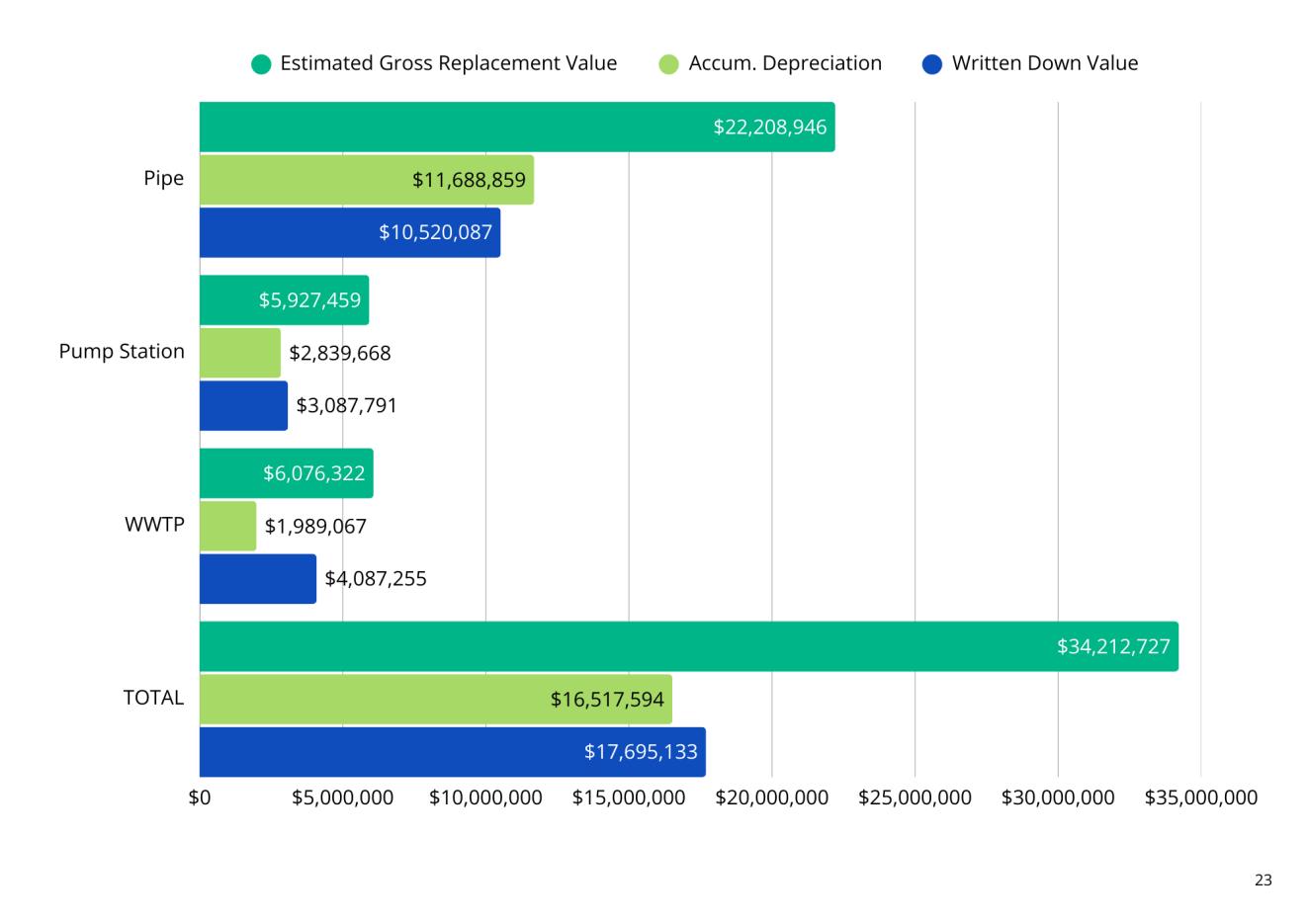
WHAT DOES IT COST?
There are two key indicators of cost to provide the CWMS service. The life cycle cost being the average cost over the life of the asset and the total maintenance and capital renewal expenditure required to deliver existing service levels over the next 10 years as detailed in Council s Long Term Financial Plan.
The average life cycle cost (made up of maintenance and depreciation) to provide the CWMS service is estimated at $1,408,448 per annum.
Council’s average planned life cycle expenditure (made up of maintenance and capital - renewal) over the next 10 years is $1,216,624. These two figures provide an initial indicator of lifecycle sustainability, which for this asset class is 86%.
The total forecast expenditure required to provide the CWMS service in the next 10 years is estimated at $18,825,314 (this incorporates maintenance, operating, capital - renewal and capital - new). This is an average of $1,882,531 per annum.
In 2024/25, Council will receive approximately $2,016,560 revenue from CWMS rates/connection service charges.
FORECAST EXPENDITURE
Operating
Operating budget includes costs associated with operating the asset and includes costs such as insurance, electricity, revaluation and minor administrative costs. The current forecast Operating expenditure over the next 10 years is $2,321,578
Maintenance
Maintenance includes costs associated with maintaining the asset. Council currently has a contract in place to desludge septic tanks. The current forecast Maintenance expenditure over the next 10 years is $4,952,182
Capital - Renewal
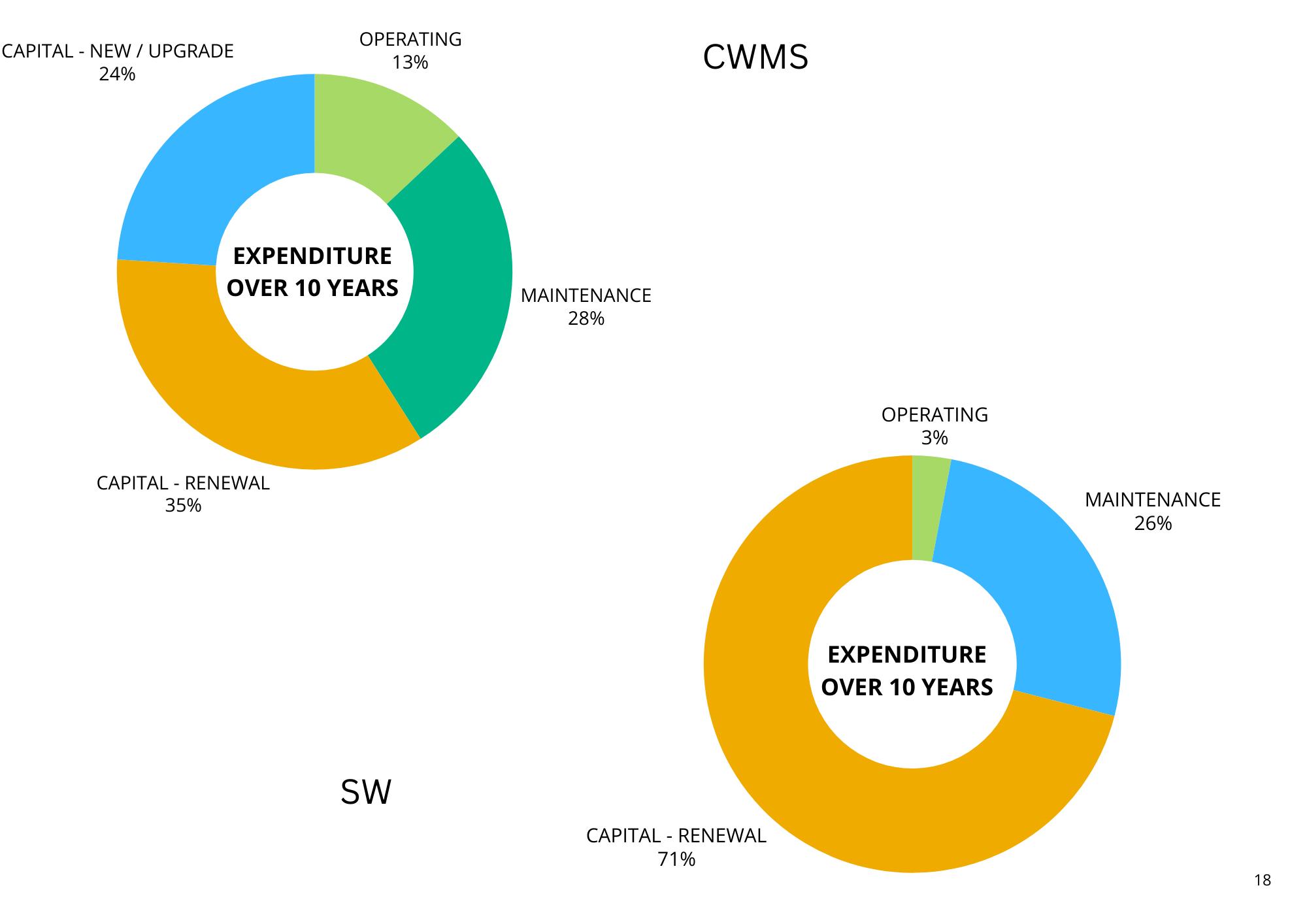
Capital - Renewal is capital costs associated with renewing or replacing current assets and infrastructure (restoring to original service level). The current forecast CapitalRenewal expenditure over the next 10 years is $7,214,054
Capital - New / Upgrade
FUTURE PRIORITIES, CHALLENGES AND OPPORTUNITIES
We completed a condition assessment of the entire CWMS network in 2022. This audit has informed future decisions with regard to the renewal and maintenance of our CWMS network. During the audit our GIS data has also been updated for the location of our CWMS assets which will ensure we have accurate information for the future.
DRAFT
Capital - New / Upgrade is capital costs associated with upgrading or creating new assets and infrastructure (above original service level). The current forecast CapitalNew expenditure over the next 10 years is $4,337,500.
During 2022, we also undertook a condition and capacity assessment of pump stations within this asset class. Future renewal of these assets utilises this capacity assessment to assist in planning for growth within our townships and in alignment
CWMS assets will be maintained in accordance with legislative requirements, environmental standards and population growth. Issues found or reported that are outside our service standard are assessed and appropriate remedial action is taken. It is our intent that an appropriate CWMS network is maintained that enables Council to convert wastewater into Class B water. This classification provides a treated water which is suitable for the irrigation of our parks and gardens.
CWMS assets will be inspected and maintained to a high standard and appropriate signage and equipment will be provided as needed to ensure public safety. We also have a Safety, Reliability, Maintenance and Technical Management Plan (SRMTMP) which has been developed to meet the requirements of the Water Industry Act 2012 and associated Water Industry Regulations as required by the Office of the Technical Regulator. The SRMTMP has been prepared to describe how the operations and maintenance employees ensure the safe and reliable operation of our collection networks, wastewater treatment facilities and recycled water use. We are committed to the safe and efficient operation of all systems through compliance with all statutory legislation, which is demonstrated by adherence to the elements described in the SRMTMP.
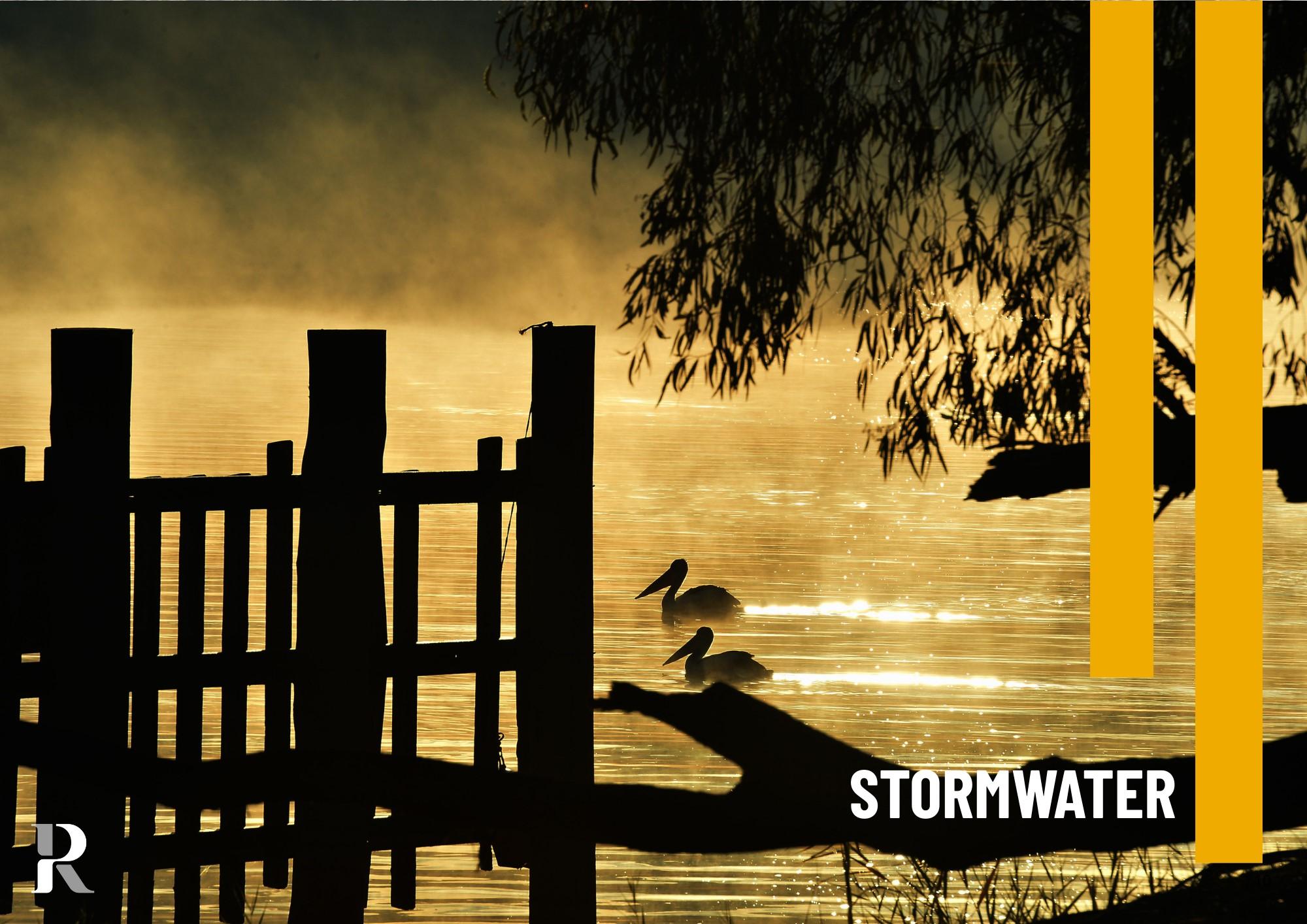
DRAFT
STORMWATER
Council provides stormwater drainage systems in Renmark, Paringa and Lyrup. This enables Council to provide the community with a means to remove and divert stormwater and ensure the quality of stormwater discharge to local creeks and rivers is to a high standard.
Between 2010 and 2016, we experienced several high rainfall events and these events identified areas of concern with regard to localised flooding and capacity of our stormwater infrastructure. Since these events and in conjunction with our current Stormwater Management Plan (2001), we have invested in several projects that addressed of these issues.
The most recent significant rainfall events in 2022 demonstrated the need to continue working on the Stormwater Management Plan review alongside our learnings from the 2022 River Murray Flood. The updated Stormwater Management Plan, will address these learnings and plan for upgrades within our network to plan for future high rainfall and flooding
There are two key indicators of cost to provide the Stormwater Drainage System service. The life cycle cost being the average cost over the life cycle of the asset and the total maintenance and capital renewal expenditure required to deliver existing service levels in the next 10 years as detailed in
The average life cycle cost (made up of maintenance and depreciation) to provide the Stormwater
s average planned life cycle expenditure (made up of maintenance and capital - renewal) over These two figures provide an initial indicator of lifecycle sustainability,
DRAFT
The total forecast expenditure required to provide the Stormwater Drainage Network service in the next 10 years is estimated at $4,487,709 (this incorporates maintenance, operating, capital - renewal and capital new / upgrade). This is an average of $448,771 per annum.
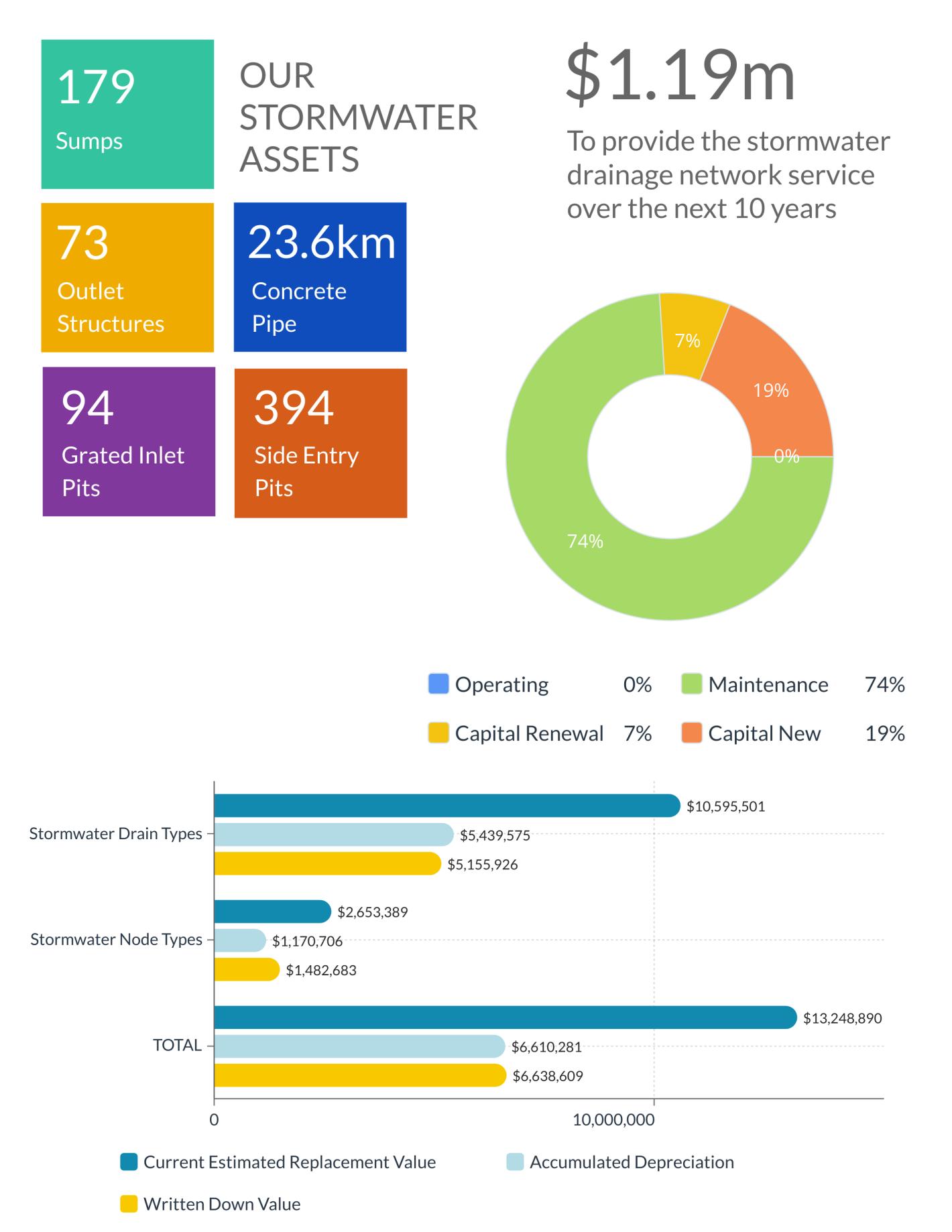
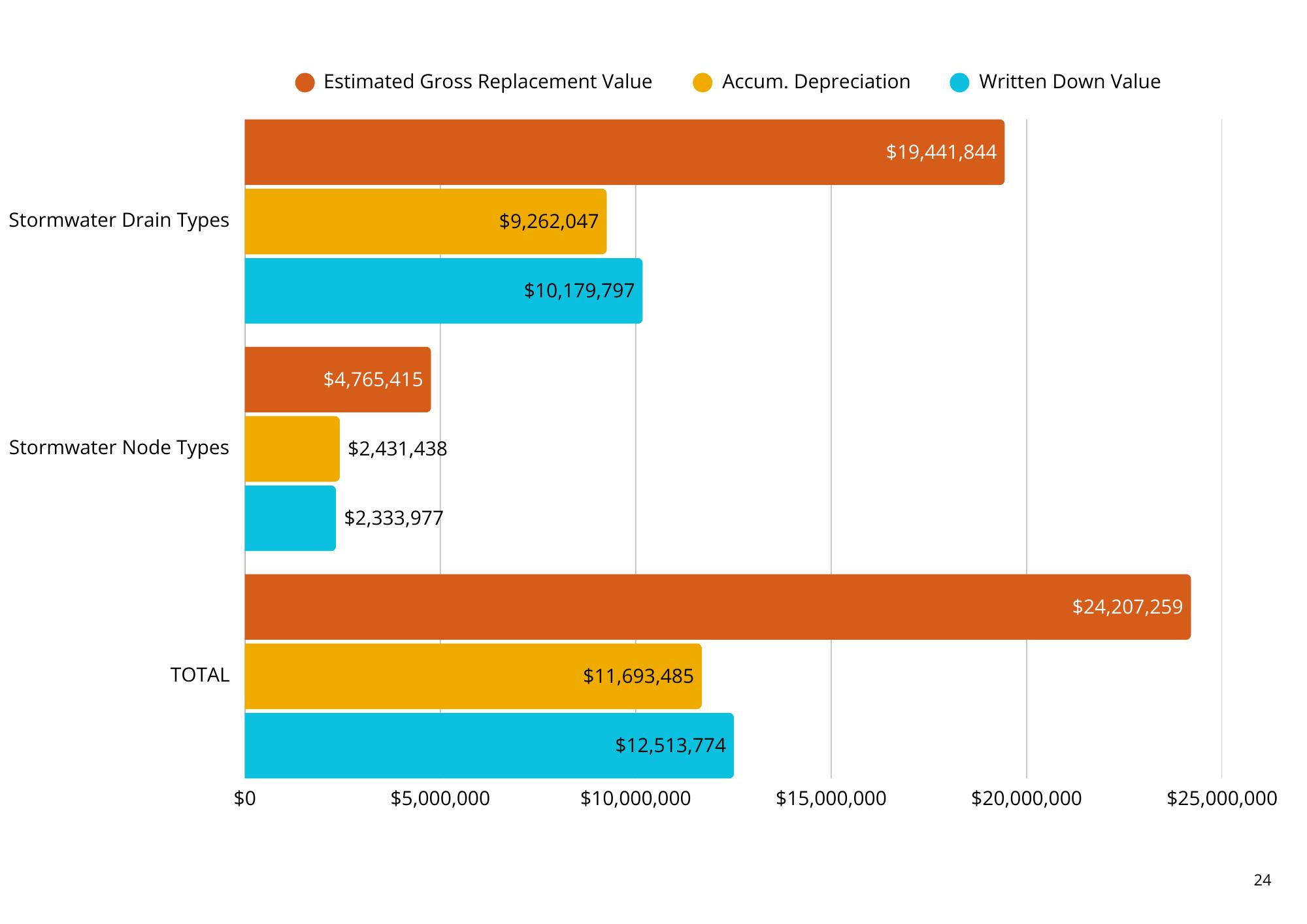
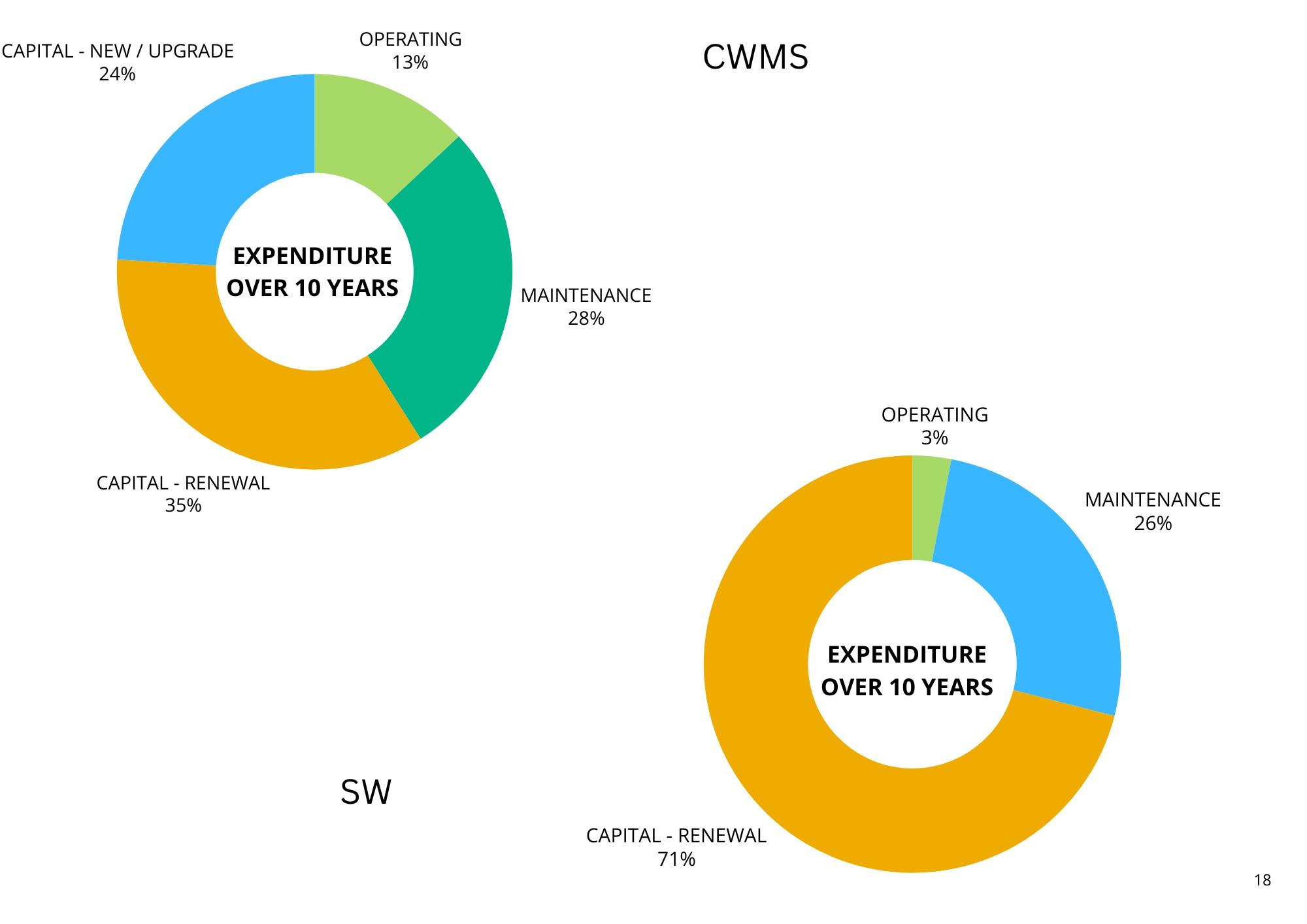
Operating includes costs associated operating the Stormwater Network. The current forecast Operating expenditure over the life of the plan is $100,750
Maintenance
Maintenance includes costs associated with maintaining the Infrastructure and Plant and Equipment. The current forecast Maintenance expenditure over the next 10 years is $1,031,369
Capital - Renewal
Capital - Renewal is capital costs associated with renewing or replacing current assets and infrastructure (restoring to original service level). The current forecast CapitalRenewal expenditure over the next 10 years is $3,355,590
Capital - New / Upgrade
There is no Capital - New / Upgrade costs included in this iteration of the IAMP. This has been excluded until the updating of our Stormwater Management Plan has been completed and is estimated to be finalised by the end of 2025. Capital Upgrades identified will be reflected in the next iteration of this plan.
FUTURE PRIORITIES, CHALLENGES AND OPPORTUNITIES
Maintaining our stormwater infrastructure has been identified as an area of high importance by the community. This is especially the case for Renmark with its flat terrain and being surrounded by water bodies. In our preparations for the 2022 River Murray Flood, we had to take extraordinary measures to block off our stormwater network to ensure the townships were protect from backflow into the system. This piece of infrastructure has been identified for betterment in our Flood Recovery Strategy 2023 and we will continue to make our infrastructure and assets more flood resilient.
Our most current Stormwater Management Plan was completed in 2001, this plan is currently under review and we expect it will inform future renewal and upgrades within the Stormwater network.
OUR STANDARDS
Quality and Function
Council’s intent is that a quality Stormwater Drainage System network is maintained, enabling Council to effectively control and discharge stormwater to limit property damage and to ensure that footpaths and roads are able to drain in an appropriate timeframe (noting that the network is designed to cater for average rainfalls and therefore may take longer to drain in rare high rainfall events).
Safety
Council inspects the Stormwater Drainage Systems regularly and repairs any identified issues to ensure they are appropriately maintained. Council has implemented a Storm Procedure that details the actions that are to occur (ie, inspecting stormwater basins, checking and readying pumping equipment and sandbags, etc) should there be a high rainfall event forecast.
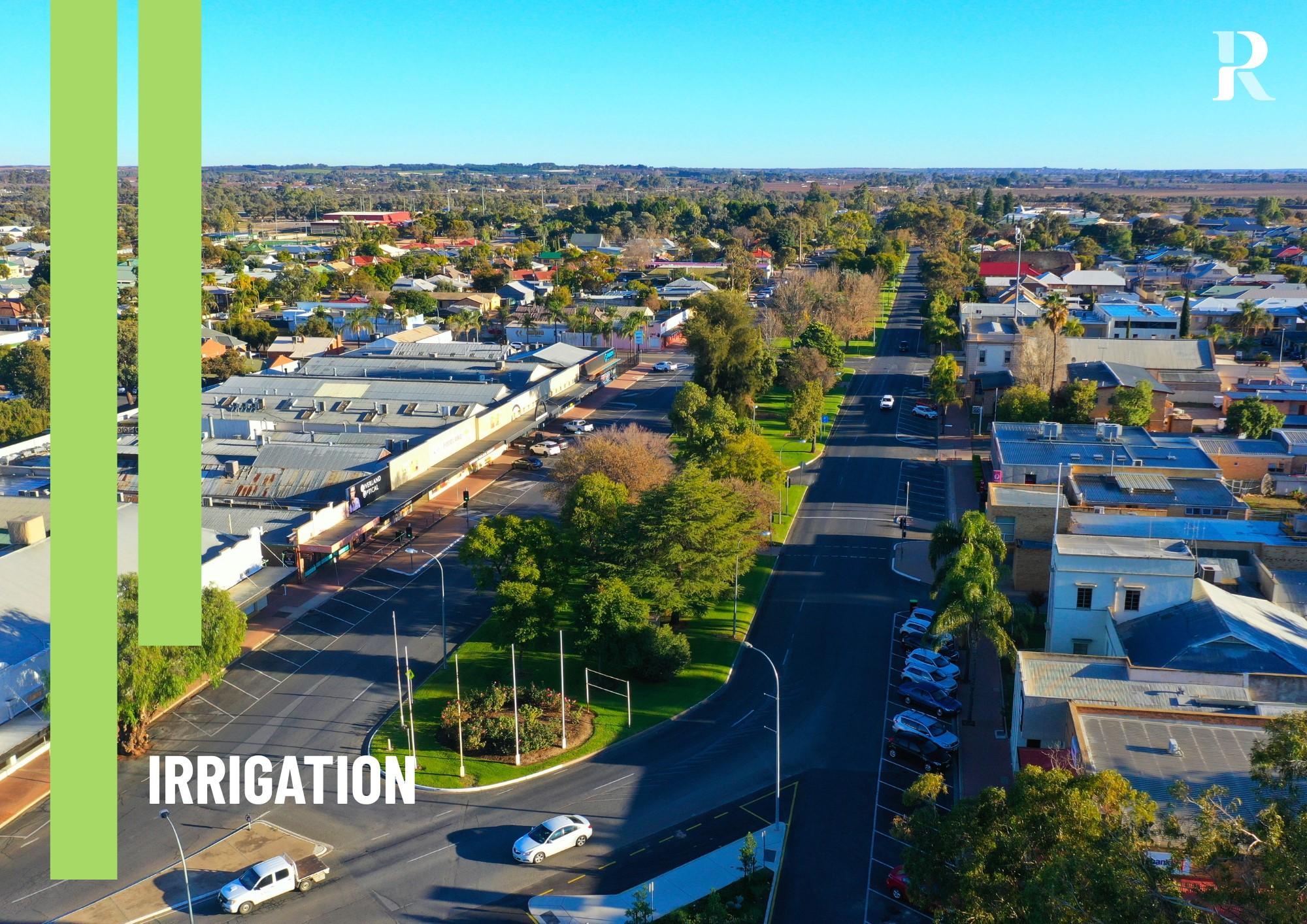
DRAFT
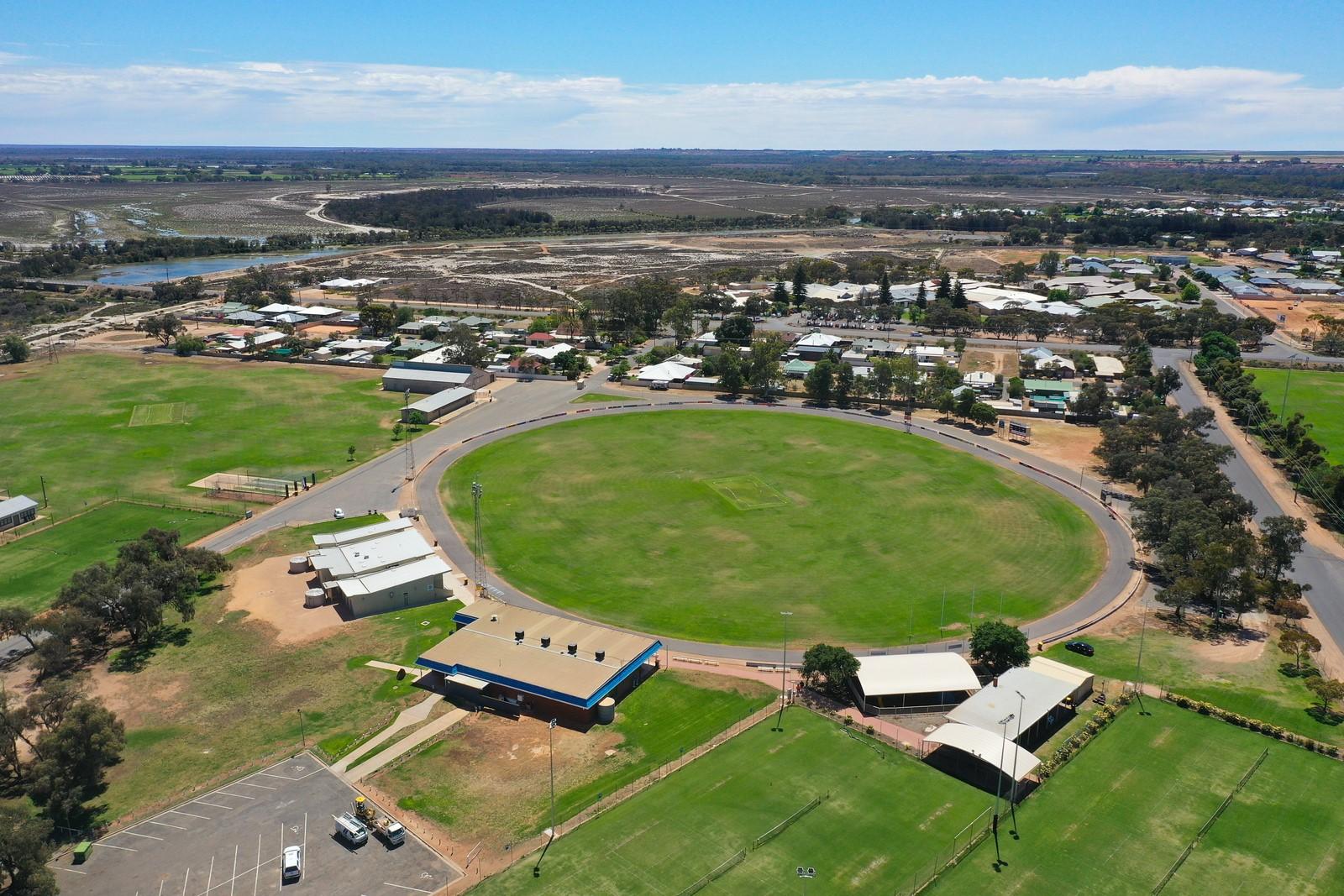
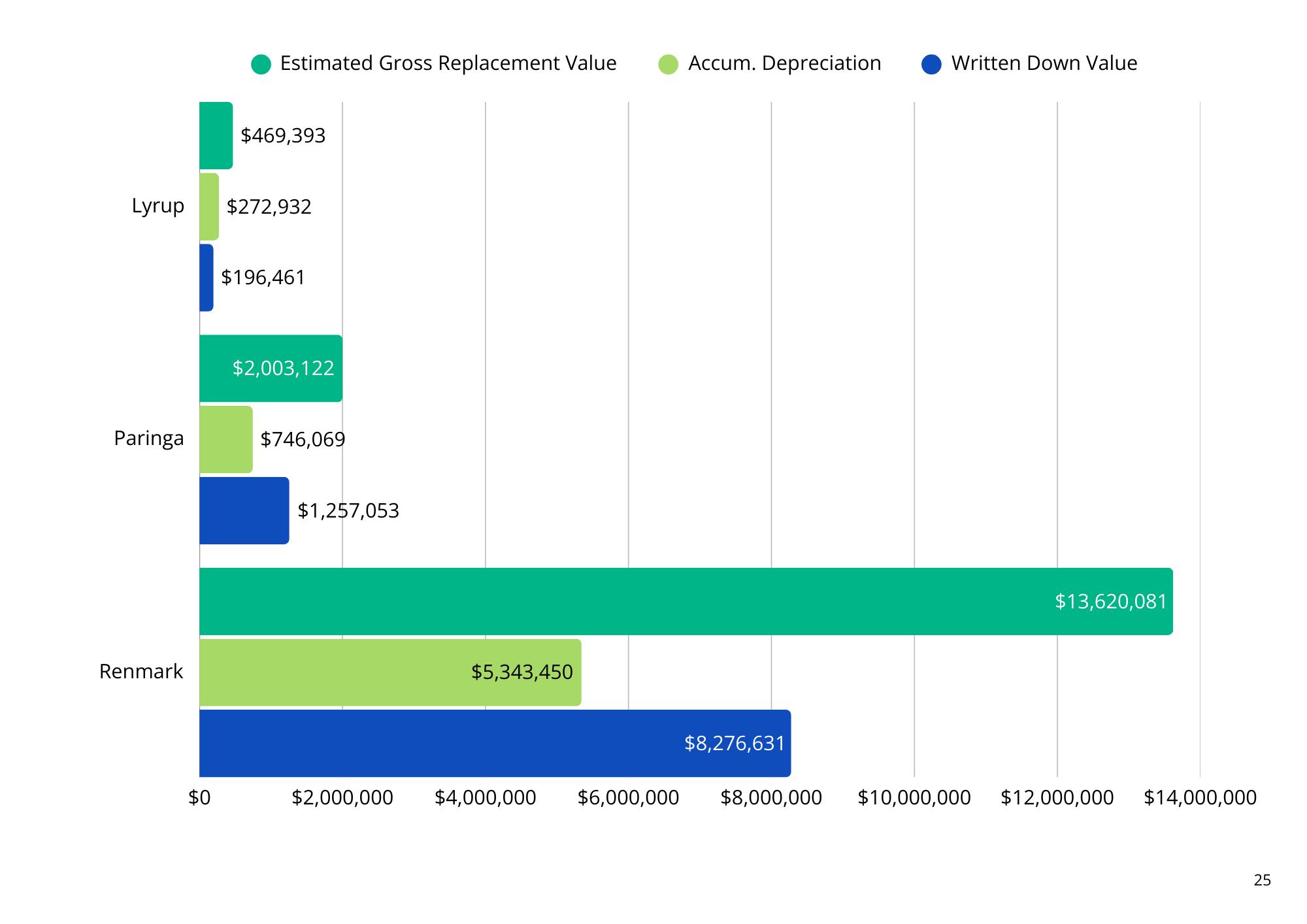
Council provides irrigation systems in Renmark, Paringa and Lyrup. This enables Council to provide high quality open space and sporting fields.
DRAFT
In 2017/18, Council successfully completed capital upgrades under the South Australian River Murray Sustainability (SARMS) Irrigation Industry Improvement Program which resulted in Council now utilising 322ML of recycled water per annum, the ability to irrigate an additional 3 hectares with recycled water and using 22ML less River Murray water per annum.
In addition to this upgrade, we have constructed another storage lagoon at the Renmark Wastewater Treatment Plant which will further reduce our reliance on River Murray water. This upgrade will increase storage capacity by 50% and reduce River Murray water use by approximately 20 million litres per year.
WHAT DOES IT COST?
The life cycle cost being the average cost over the life cycle of the asset and the total maintenance and capital renewal expenditure required to deliver existing service levels in the next 10 years as detailed in Council’s Long Term Financial Plan.
The average life cycle cost (made up of maintenance and depreciation) to provide an Irrigation System network is estimated at $680,340 per annum.
Council s average planned life cycle expenditure (made up of maintenance and capital - renewal) over the next 10 years is $521,348. These two figures provide an initial indicator of lifecycle sustainability, which for this asset class is 77%.
The total forecast expenditure required to provide the Irrigation service in the next 10 years is estimated at $5,233,758 (this incorporates maintenance, operating, capital - renewal and capital - new/ upgrade). This is an average of $523,376 per annum.
Chart: Current Valuation of the Irrigation Network
FORECAST EXPENDITURE
Operating
Operating includes costs associated operating the Irrigation Network. The current forecast Operating expenditure over the life of the plan is $20,282.
Maintenance
Maintenance includes costs associated with maintaining the Infrastructure and Plant and Equipment. The current forecast Maintenance expenditure over the next 10 years is $2,495,651.
Capital - Renewal
Capital - Renewal is capital costs associated with renewing or replacing current assets and infrastructure (restoring to original service level). The current forecast Capital - Renewal expenditure over the next 10 years is $2,717,824.
Capital - New / Upgrade
Capital - New / Upgrade is capital costs associated with upgrading or creating new assets and infrastructure (above original service level). The current forecast Capital - New expenditure over the next 10 years is $0.
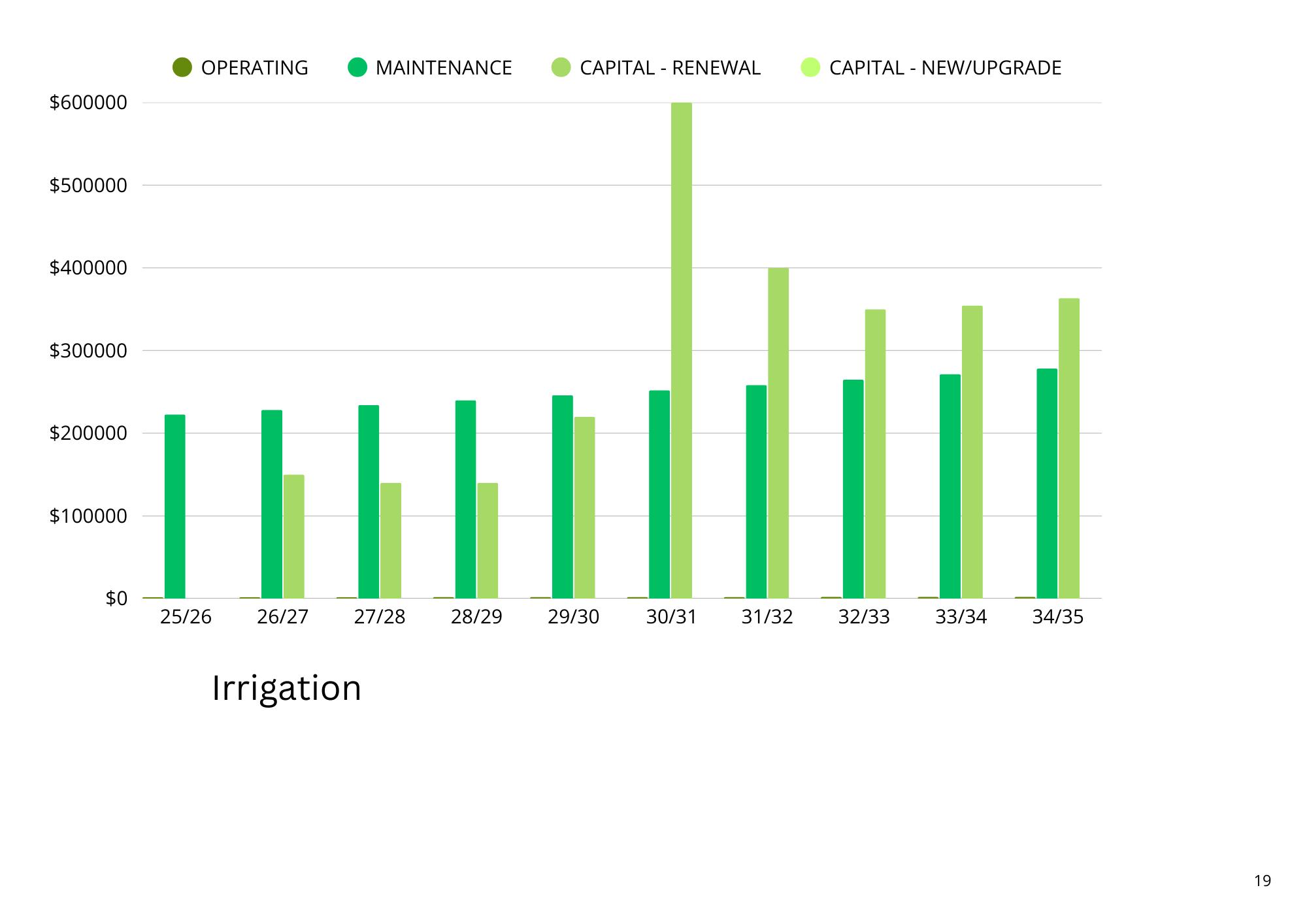
FUTURE PRIORITIES, CHALLENGES AND OPPORTUNITIES
This class underwent a full condition assessment 2023/24. This process included asset identification, condition assessment and spatial survey of all irrigation assets to develop an asset register. This information has been integrated into our asset management program to allow for the forward planning of asset renewals and broader asset management activities. These renewals have been included in this iteration of our IAMP for the first time since adding this asset class to our IAMP.
DRAFT
The irrigation assets were also introduced into our proactive maintenance management pilot during 2024/25, where routine inspections undertaken by our operations team identify and program maintenance works and assist with future planning.
OUR STANDARDS
Quality and Function
Irrigation system assets will be maintained at an optimal condition. Issues found or reported will be assessed and remedial action taken. Council’s intent is that an appropriate irrigation network is operated and maintained, enabling Council to efficiently irrigate public open space and sporting fields.
Safety
Irrigation System assets will be maintained at an appropriately safe level and signage and equipment will be provided as needed to ensure public safety. Council ensures compliance with relevant approvals and guidelines for the management of treated waste water in public open space areas.
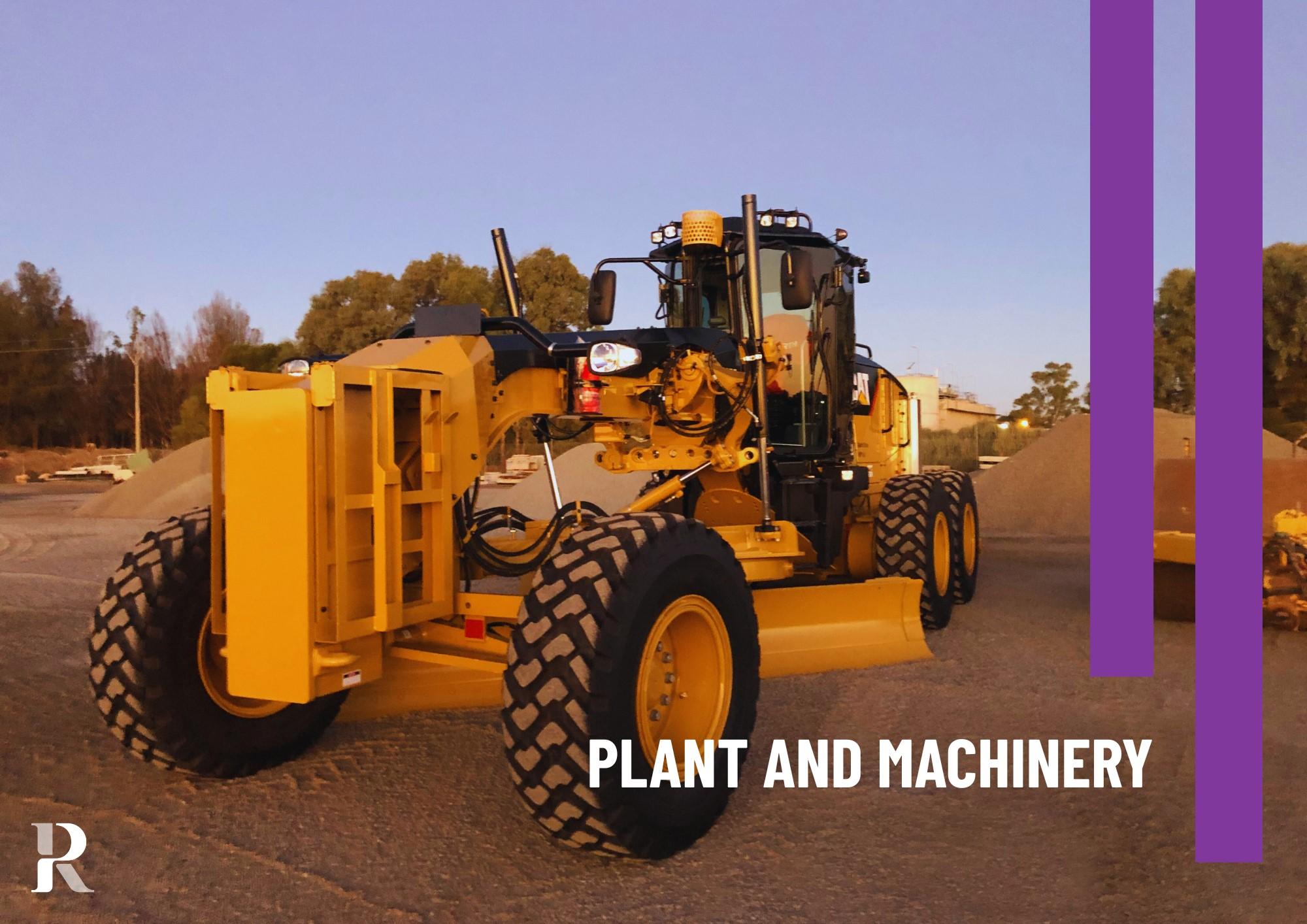
DRAFT
PLANT AND MACHINERY
To ensure Council undertakes its role and responsibilities effectively and efficiently within the Community, it requires good quality modern plant and equipment. Council staff are always attempting to discover innovative ways to improve how plant and equipment is used cost effectively.
WHAT DOES IT COST?
The life cycle cost being the average cost over the life of the asset and the total maintenance and capital renewal expenditure required to deliver existing service levels in the next 10 years as detailed in Council’s Long Term Financial Plan.
The average life cycle cost (made up of maintenance and depreciation) to provide Plant and Equipment is estimated at $417,505 per annum.
Council’s average planned life cycle expenditure (made up of maintenance and capital - renewal) over the next 10 years is $750,856.
The total forecast expenditure required to provide plant and machinery in the next 10 years is estimated at $10,919,063 (this incorporates maintenance, operating, capital - renewal and capitalnew / upgrade). This is an average of $1,091,906 per annum.
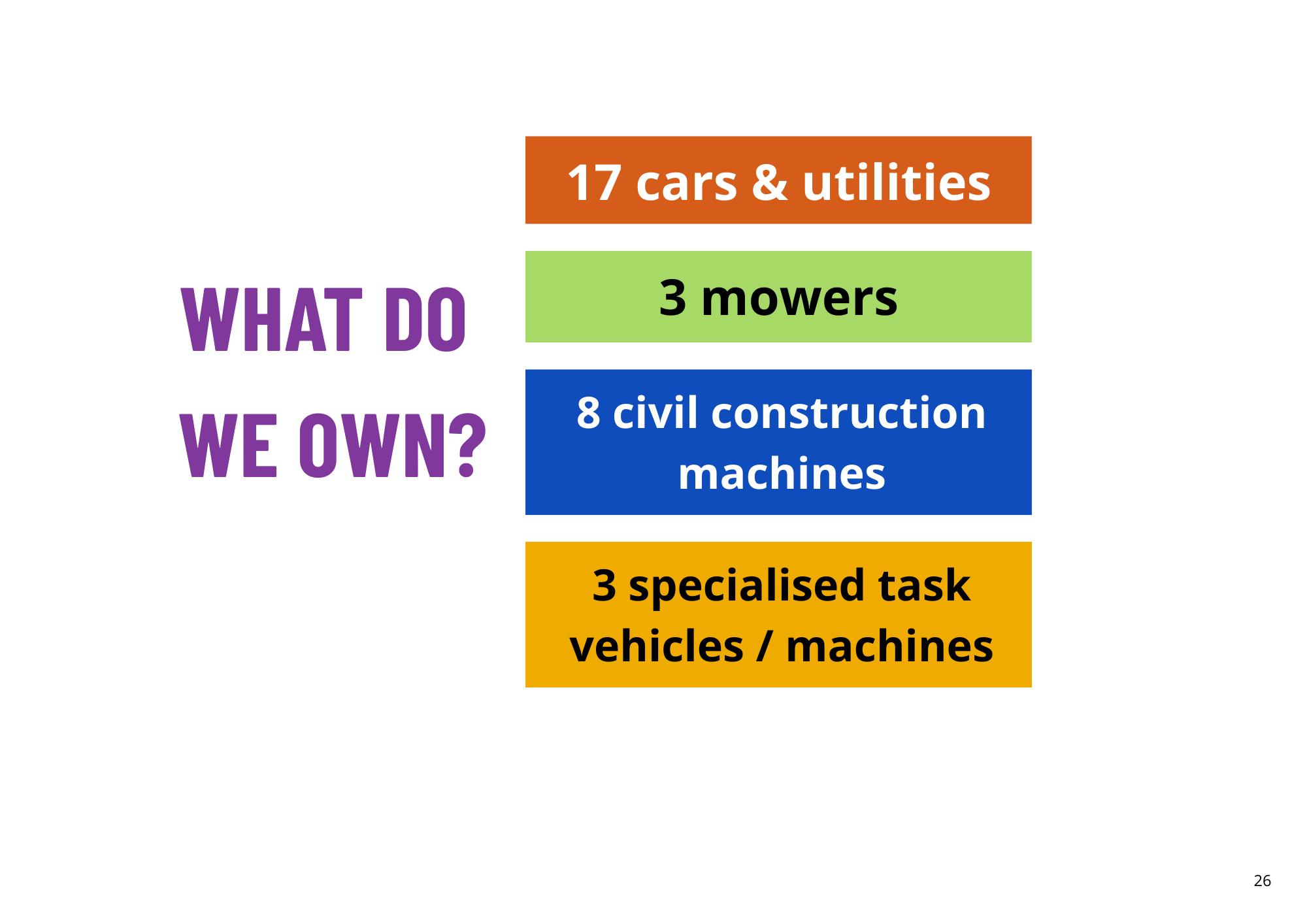
$5.22m estimated value of our plant and machinery
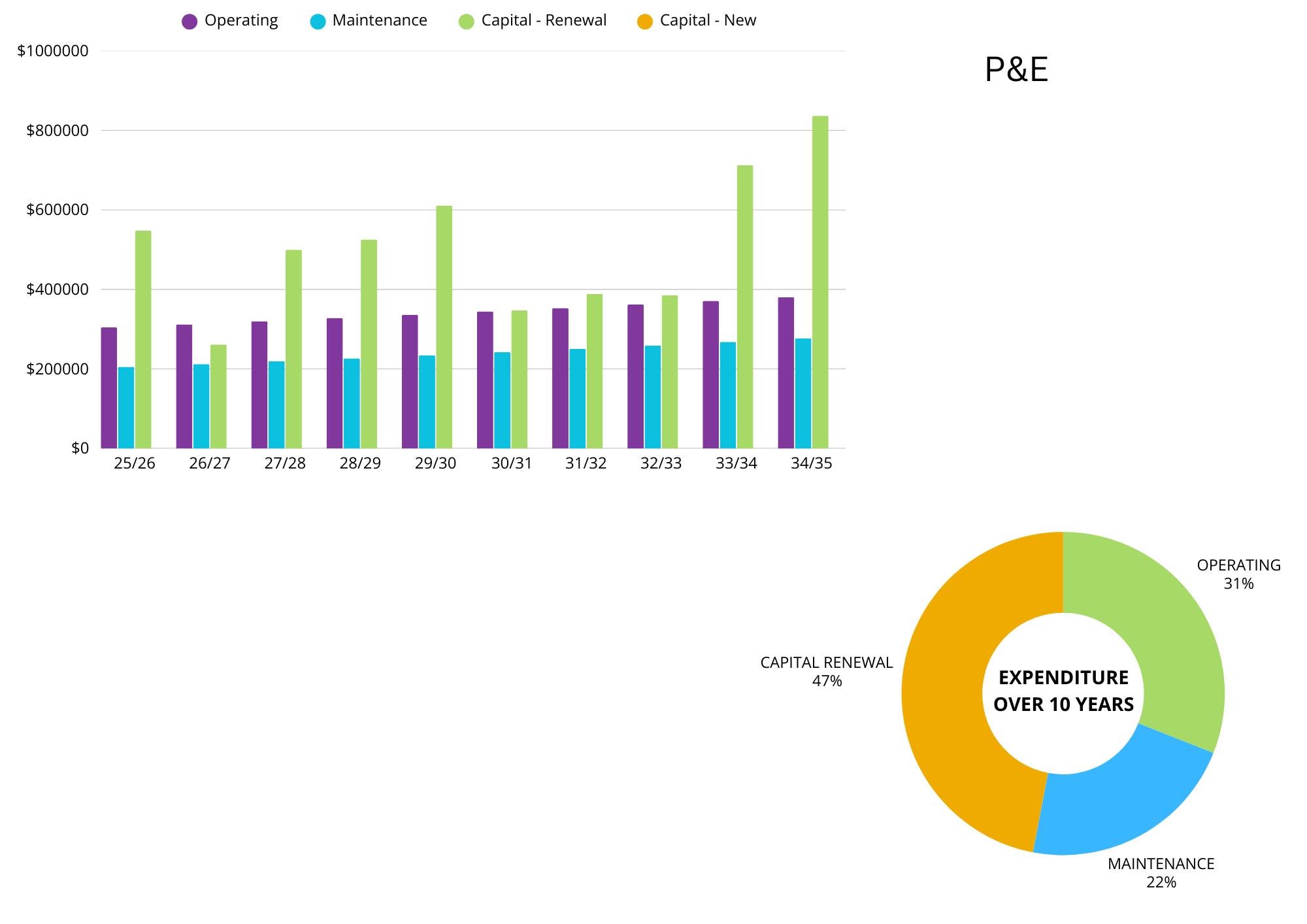

Operating
Operating budget includes revaluation costs. The current forecast Operating expenditure over the next 10 years is $3,410,504.
Maintenance
Maintenance includes costs associated with maintaining the Infrastructure and Plant and Equipment. The current forecast Maintenance expenditure over the next 10 years is $2,393,104.
Capital - Renewal
Capital - Renewal is capital costs associated with renewing or replacing current assets and infrastructure (restoring to original service level). The current forecast Capital - Renewal expenditure over the next 10 years is $5,115,455.
Capital - New / Upgrade
Capital - New / Upgrade is capital costs associated with upgrading or creating new assets and infrastructure (above original service level). The current forecast Capital - New expenditure over the next 10 years is $0.
FUTURE PRIORITIES, CHALLENGES AND OPPORTUNITIES
We will continue to identify opportunities for savings with regard to the renewal of our plant and machinery and to ensure our replacement program achieves the best value for our community.
OUR STANDARDS
Quality and Function
It is imperative that plant and equipment is renewed at the optimal intervals and staff have a motor vehicle procurement policy that directs when these intervals should occur. Larger plant is renewed when trade in price is optimal and minor plant and equipment is changed as needed.
Safety
All staff are trained to use Council’s plant and equipment before use to ensure accidents to property, the community and staff are minimised.
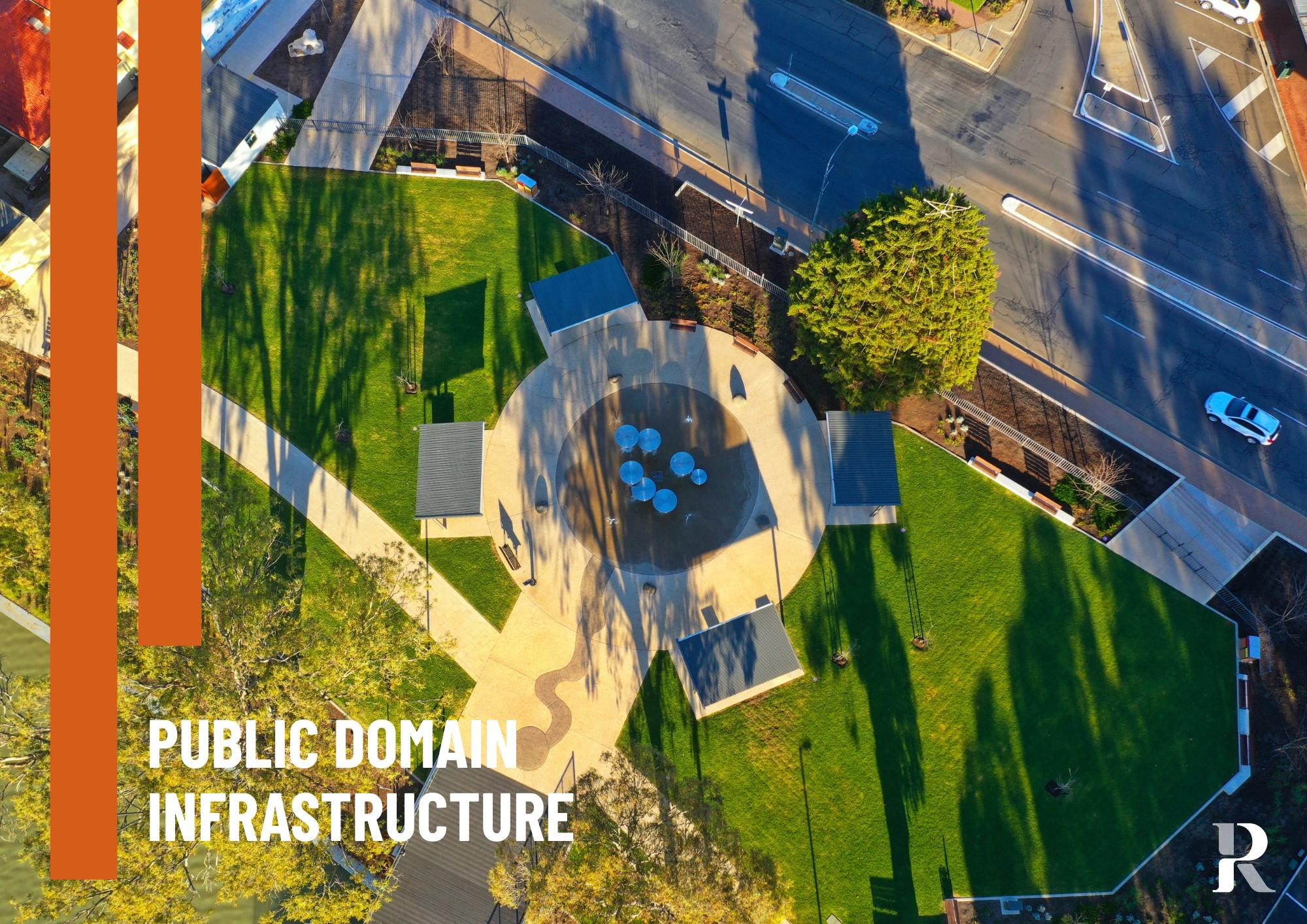
DRAFT
PUBLIC DOMAIN INFRASTRUCTURE
WHAT DOES IT COST?
The life cycle cost being the average cost over the life of the asset and the total maintenance and capital renewal expenditure required to deliver existing service levels in the next 10 years as detailed in Council s Long Term Financial Plan.
The average life cycle cost (made up of maintenance and depreciation) to provide Public Domain Infrastructure is estimated at $1,683,003 per annum.
Council’s average planned life cycle expenditure (made up of maintenance and capitalrenewal) over the next 10 years is $1,737,342. These two figures provide an initial indicator of lifecycle sustainability, which for this asset class is 103%.
The total forecast expenditure required to provide Public Domain Infrastructure in the next 10 years is estimated at $24,392,417 (this incorporates maintenance, operating, capital - renewal and capital - new / upgrade). This is an average of $2,439,242 per annum.
Public Domain Infrastructure are assets that are used by the community on a regular basis such as street furniture and playgrounds. They are often subject to the external elements and therefore it is imperative to choose both aesthetically pleasing and hard wearing items that will require replacement less often.
FORECAST EXPENDITURE
Operating
Operating budget includes revaluation and operating projects. The current forecast Operating expenditure over the next 10 years is $6,788,992
Maintenance
Maintenance includes costs associated with maintaining the assets within the public domain. The current forecast maintenance expenditure over the next 10 years is $9,551,202.
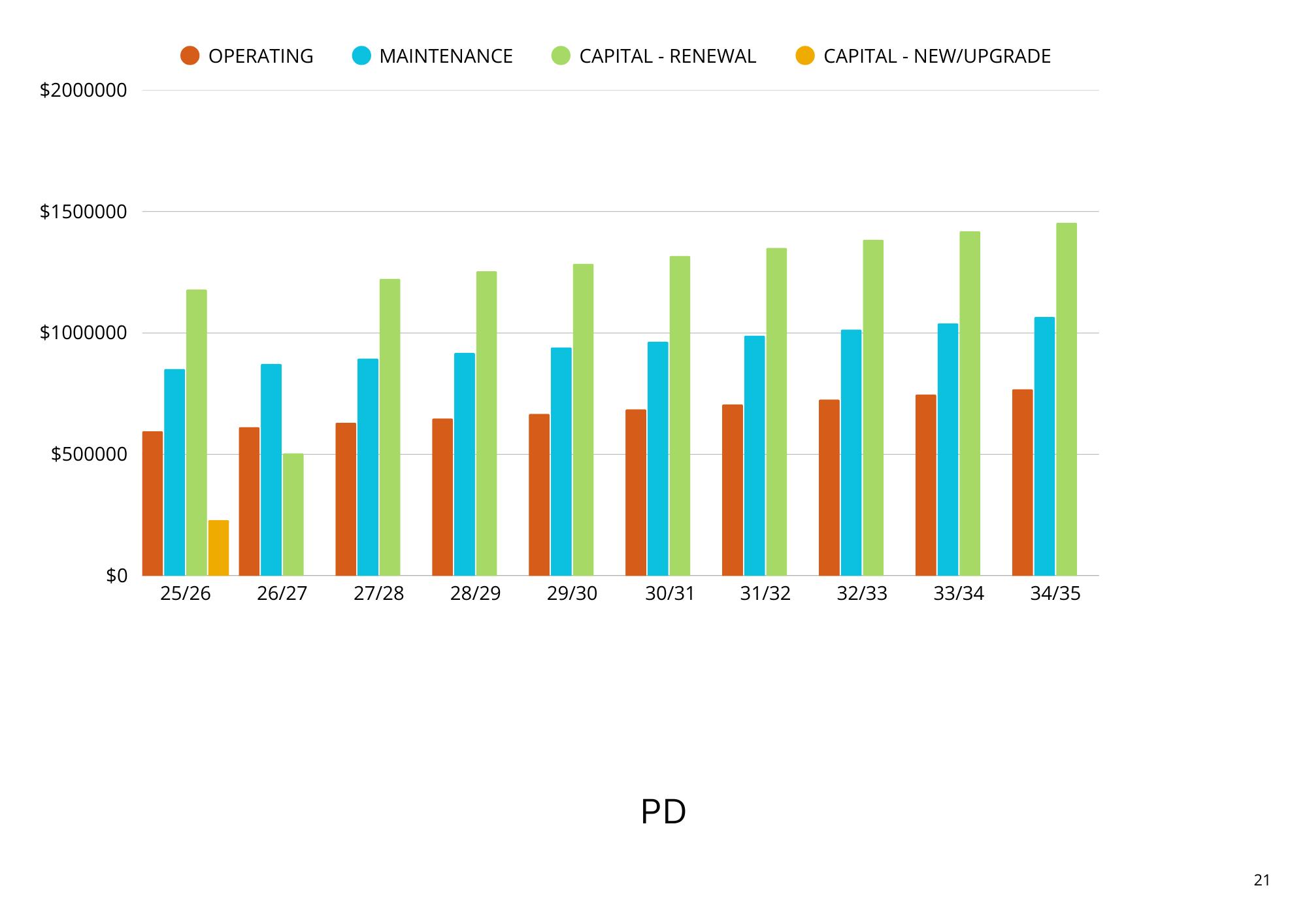
Capital - Renewal
Capital - Renewal is capital costs associated with renewing or replacing current assets and infrastructure (restoring to original service level). The current forecast CapitalRenewal expenditure over the next 10 years is $7,822,223.
Capital - New / Upgrade
Capital - New / Upgrade is capital costs associated with upgrading or creating new assets and infrastructure (above original service level). The current forecast CapitalNew expenditure over the next 10 years is $230,000.
FUTURE PRIORITIES, CHALLENGES AND OPPORTUNITIES
As we continue to undertake condition assessments on our asset classes, the public domain infrastructure category will be incorporated into this schedule. This asset class consists of a large array of infrastructure which requires differing levels of inspections and assessments. We will aim to complete a condition assessment during the life of this plan.
Playgrounds form part of this asset class and we maintain a regular auditing process for these assets to ensure they are safe and fit for purpose. This iteration of the plan has included a playground renewal program within the appendices. This renewal activity will be conducted in consultation with the community.
Council endorsed a Boat Ramp Strategy in May 2021 which has been included within the future years of the capital programs, to view the full strategy, please visit our website.
This asset class has in the past had large capital new / upgrade projects which have required significant investment from Council. The projects identified for future investment are Stages 2 and 5 of the Urban Design Framework and the Darnley Taylor Park Masterplan. These projects may be considered for inclusion in the future subject to:
• Receiving at least 50% external funding
• A cost benefit analysis with emphasis on the impact on operational expenditure and the LTFP.
• An analysis of the economic, social and environmental benefits the project will bring to the community.
OUR STANDARDS
Quality and Function
Visitors to the Renmark Paringa Council area regularly comment on the quality of the street furniture, BBQ’s, sporting facilities and gardens. Our staff liaise with consultants and contractors to ensure we have access to the latest in design to ensure we install the most cost effective Public Domain Infrastructure are installed.
Safety
DRAFT
These Public Domain assets need both regular maintenance and replacement due to the amount of community use. To ensure these assets remain at a high standard and fit for purpose they are regularly inspected and replaced when required.
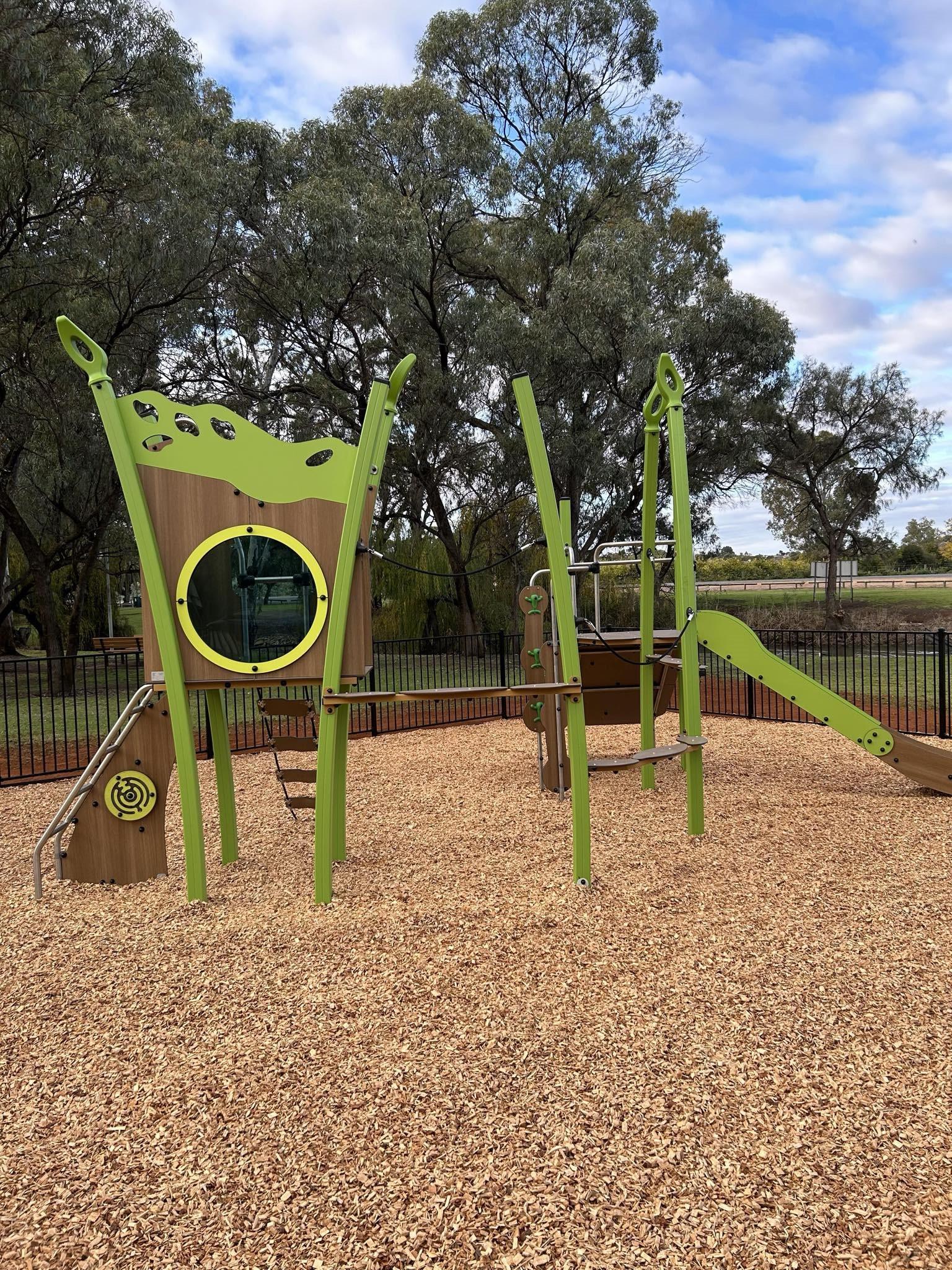
FURNITURE AND FITTINGS
This asset category includes our office equipment such as furniture and fittings to ensure Council staff are able to undertake their daily duties, they are provided with ergonomic furniture and fittings. The quality of such furniture and fitting is chosen so that replacement of such items occurs less often.
WHAT DOES IT COST?
The life cycle cost being the average cost over the life of the asset and the total maintenance and capital renewal expenditure required to deliver existing service levels in the next 10 years as detailed in Council s Long Term Financial Plan.
The average life cycle cost (made up of maintenance and depreciation) to provide furniture and fittings is estimated at $26,730 per annum. Council’s average planned life cycle expenditure (made up of maintenance and capital - renewal) over the next 10 years is $26,730. These two figures provide an initial indicator of lifecycle sustainability, which for this asset class is 89%.
The total forecast expenditure required to provide furniture and fittings in the next 10 years is estimated at $267,296 (this incorporates maintenance, operating, capital renewal and capital - new). This is an average of $26,730 per annum.

FORECAST EXPENDITURE
Maintenance
Maintenance includes costs associated with maintaining the office equipment. The current forecast Maintenance expenditure over the next 10 years is $267,296
Capital - Renewal
Capital - Renewal is capital costs associated with renewing or replacing current assets and infrastructure (restoring to original service level). The current forecast Capital - Renewal expenditure over the next 10 years is $0.
FUTURE PRIORITIES, CHALLENGES AND OPPORTUNITIES
We have yet to audit our furniture and fittings to determine what is required for capital renewal and capital upgrade. We do believe this asset in is generally good condition and as such it is proposed that the audit of our furniture and fittings assets occurs once we have completed our major asset classes.
OUR STANDARDS
Quality and Function
Council staff analyses numerous furniture options to ensure the best quality is found for the best price. Staff choose furniture and fittings that will provide ergonomic support and reduce the risk of long term injury whilst reducing the frequency of replacement.
Safety
Faulty furniture and fittings are either repaired or replaced following inspection. Council have purchased a number of stand up desks to encourage staff to be more mobile at their desks.
GLOSSARY
Asset class
Grouping of assets of a similar nature and use in an entity's operations (AASB 166.37).
Asset condition assessment
The process of continuous or periodic inspection, assessment, measurement and interpretation of the resultant data to indicate the condition of a specific asset so as to determine the need for some preventative or remedial action.
Asset management
The combination of management, financial, economic, engineering and other practices applied to physical assets with the objective of providing the required level of service in the most cost effective manner.
Assets
Future economic benefits controlled by the entity as a result of past transactions or other past events (AAS27.12). Property, plant and equipment including infrastructure and other assets (such as furniture and fittings) with benefits expected to last more than 12 month.
Capital expenditure
Relatively large (material) expenditure, which has benefits, expected to last for more than 12 months. Capital expenditure includes renewal, expansion and upgrade. Where capital projects involve a combination of renewal, expansion and/or upgrade expenditures, the total project cost needs to be allocated accordingly.
Capital funding
Funding to pay for capital expenditure.
Capital grants
Monies received generally tied to the specific projects for which they are granted, which are often upgrade and/or expansion or new investment proposals.
Capital investment expenditure
See capital expenditure definition.
Capital new expenditure
Expenditure which creates a new asset providing a new service to the community that did not exist beforehand or which enhances an existing asset to provide a higher level of service or expenditure that will increase the life of the asset beyond that which it had originally. As it increases service potential it may impact revenue and will increase future operating and maintenance expenditure.
Capital renewal expenditure
Expenditure on an existing asset, which returns the service potential or the life of the asset up to that which it had originally. It is periodically required expenditure, relatively large (material) in value compared with the value of the components or sub-components of the asset being renewed. As it reinstates existing service potential, it has no impact on revenue, but may reduce future operating and maintenance expenditure if completed at the optimum time, eg. resurfacing or resheeting a material part of a road network, replacing a material section of a drainage network with pipes of the same capacity, resurfacing an oval. Where capital projects involve a combination of renewal, expansion and/or upgrade expenditures, the total project cost needs to be allocated accordingly.
Current replacement cost (CRC)
business or the minimum it would cost, to replace the existing asset with a technologically modern equivalent new asset (not a second hand one) with the same economic benefits (gross service potential) allowing for any differences in the quantity and quality of output and in operating costs.
Current replacement cost “As New” (CRC)
The current cost of replacing the original service potential of an existing asset, with a similar modern equivalent asset, i.e. the total cost of replacing an existing asset with an as NEW or similar asset expressed in current dollar values.
Depreciable amount
The cost of an asset, or other amount substituted for its cost, less its residual value (AASB 116.6)
Depreciated replacement cost (DRC)
The current replacement cost (CRC) of an asset less, where applicable, accumulated depreciation calculated on the basis of such cost to reflect the already consumed or expired future economic benefits of the asset
Depreciation / amortisation
The systematic allocation of the depreciable amount (service potential) of an asset over its useful life.
Expenditure
The spending of money on goods and services. Expenditure includes recurrent and capital.
Fair value
Fair value is based on market value, where that exists, or otherwise replacement cost as per AASB13.
Infrastructure assets
Physical assets of the entity or of another entity that contribute to meeting the public's need for access to major economic and social facilities and services, eg. roads, drainage, footpaths and cycleways. These are typically large, interconnected networks or portfolios of composite assets The components of these assets may be separately maintained, renewed or replaced individually so that the required level and standard of service from the network of assets is continuously sustained. Generally the components and hence the assets have long lives. They are fixed in place and are often have no market value.
Level of service
The defined service quality for a particular service against which service performance may be measured. Service levels usually relate to quality, quantity, reliability, responsiveness, environmental, acceptability and cost.
Life Cycle Cost
Remaining life
Accounting definition used to indicate the time remaining until an asset ceases to provide the required service level or economic usefulness, not an engineering assessment. Age plus remaining life is economic life.
Renewal
See capital renewal expenditure definition above.
Residual value
The net amount which an entity expects to obtain for an asset at the end of its useful life after deducting the expected costs of disposal.
Risk management
The application of a formal process to the range of possible values relating to key factors associated with a risk in order to determine the resultant ranges of outcomes and their probability of occurrence.
Section or segment
A self-contained part or piece of an infrastructure asset.
Service potential
The capacity to provide goods and services in accordance with the entity's objectives, whether those objectives are the generation of net cash inflows or the provision of goods and services of a particular volume and quantity to the beneficiaries thereof.
Service potential remaining
A measure of the remaining life of assets expressed as a percentage of economic life. It is also a measure of the percentage of the asset s potential to provide services that is still available for use in providing services (DRC/ DA).
Strategic Management Plan (SA)
Documents Council objectives for a specified period (3-5 yrs), the principle activities to achieve the objectives, the means by which that will be carried out, estimated income and expenditure, measures to assess performance and how rating policy relates to the Council’s objectives and activities.
Useful life
Either:
(a) the period over which an asset is expected to be available for use by an entity, or
(b) the number of production or similar units expected to be obtained from the asset by the entity.
It is estimated or expected time between placing the asset into service and removing it from service, or the estimated period of time over which the future economic benefits embodied in a depreciable asset, are expected to be consumed by the council. It is the same as the economic life.
Value in Use
DRAFT
The life cycle cost (LCC) is average cost to provide the service over the longest asset life cycle. It comprises annual maintenance and asset consumption expense, represented by depreciation expense. The Life Cycle Cost does not indicate the funds required to provide the service in a particular year.
Life Cycle Expenditure
The Life Cycle Expenditure (LCE) is the actual or planned annual maintenance and capital renewal expenditure incurred in providing the service in a particular year. Life Cycle Expenditure may be compared to Life Cycle Cost to give an initial indicator of life cycle sustainability.
The present value of estimated future cash flows expected to arise from the continuing use of an asset and from its disposal at the end of its useful life. It is deemed to be depreciated replacement cost (DRC) for those assets whose future economic benefits are not primarily dependent on the asset's ability to generate new cash flows, where if deprived of the asset its future economic benefits would be replaced.
Written-Down Value (WDV)
The cost the entity would incur to acquire the asset on the reporting date. The cost is measured by reference to the lowest cost at which the gross future economic benefits could be obtained in the normal course of
Life Cycle Sustainability Index
Life Cycle Expenditure may be compared to Life Cycle Expenditure to give an initial indicator of life cycle sustainability.
The value of an asset after accounting for depreciation or amortization. It is calculated by subtracting accumulated depreciation or amortization from the asset's original value. Written-down value reflects the asset's present worth from an accounting perspective.
Adapted from: DVC 2006, Glossary
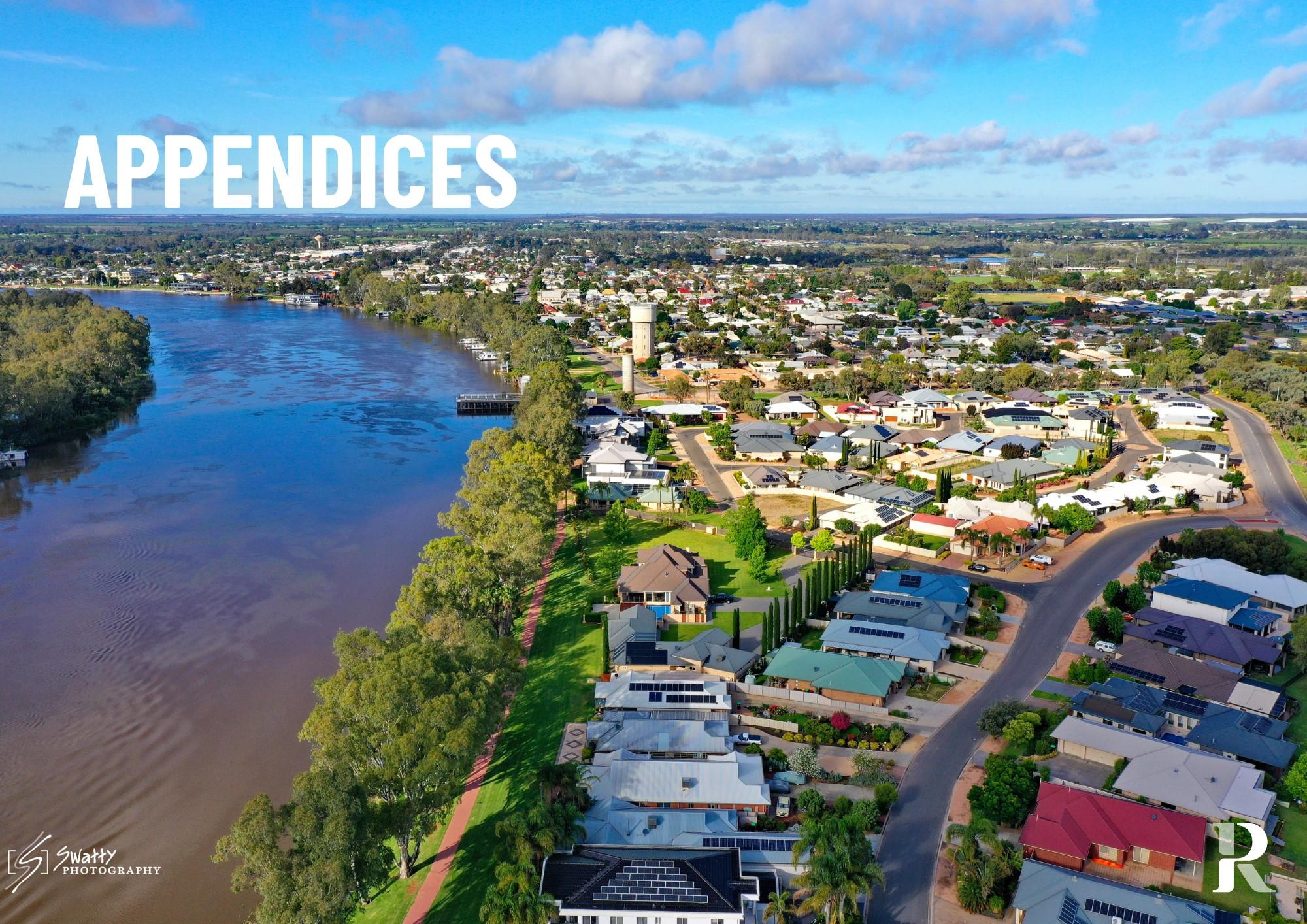
DRAFT
Appendix 1: 10 Year Capital Expenditure Summary

Yearly Average Capital Investment
ASSUMPTIONS
• The following tables outline the capital programs over the life of this plan by asset class, of which an 2.5% indexation has been applied to address inflation. The operating and maintenance costs are represented in Appendix 4.
• There are projects which are subject to external funding or have external funding sources allocated. Where an asterisk is noted, this indicates a project will not proceed without external grant funds.
DRAFT
• Council receives Roads to Recovery Program from the Australian Federal Government. The current program spans from 2024-2029. The years beyond this program life have assumed the year 5 allocation of the current program. Due to the uncertainty of the future allocations for this program, we have allowed a conversative funding value from 2030.
• Additionally, it should be noted the Roads to Recovery funding has been captured as capital income for the purposes of this document. We acknowledge this is identified as an operating grant in the Long Term Financial Plan and associated financial statements.
• Following the advice received from ESCOSA, Council has incorporated provisions in the outer years of the plan to account for asset renewals that are not yet quantified. This has been implemented to align to Council's asset renewal ratio.
Appendix 2: Capital Program 2025/26
PUBLIC DOMAIN INFRASTRUCTURE
* Will not proceed without External Funding

Appendix 3: Capital Expenditure: Years 2-10

Wall Finishes, Hot Water Systems (roof and staff room), Electrical Systems, Fire and Safety Systems, Security System
Wall Finishes, Doors (roller/screen), hot water systems, Electrical Systems, Security Systems, Gutters/Downpipes, Evaporative Units (Squash & Reception)
Security System, Gutters and Downpipes, Floor Coverings (Wood Pavillion), Internal Wall Finishes, Hot Water Systems, Electrical Systems (HS Taylor Grandstand), Internal Wall Finishes and Gutters and Downpipes (Kindergym); Electrical Systems and Roof Gutters and Downpipes (KM Tucker Hall)
Wall Finishes, Electrical Systems, Security System, Reverse Cycle
and
Systems, Gutters and Downpipes,
Note: A full Building & Structure Condition Assessment has been scheduled for 2025/26 which will inform the above forecasts to align to the asset's current condition. These changes will be reflected in the next revision of this document.

CWMS

Calperum Industrial Estate CWMS Disposal (Year 2 of 2)
Construction budget has been estimated based on the Options Assessment and Multi-Criteria Analysis completed in 2025. This project will not proceed unless external grant funds are secured.
Stormwater

Council is currently undertaking a Stormwater Management Plan and is yet to finalise the Stormwater Condition Assessment. This will inform the future renewals and upgrades based on condition and network improvements
Irrigation

Major Plant & Equipment
DRAFT

Public Domain Infrastructure

